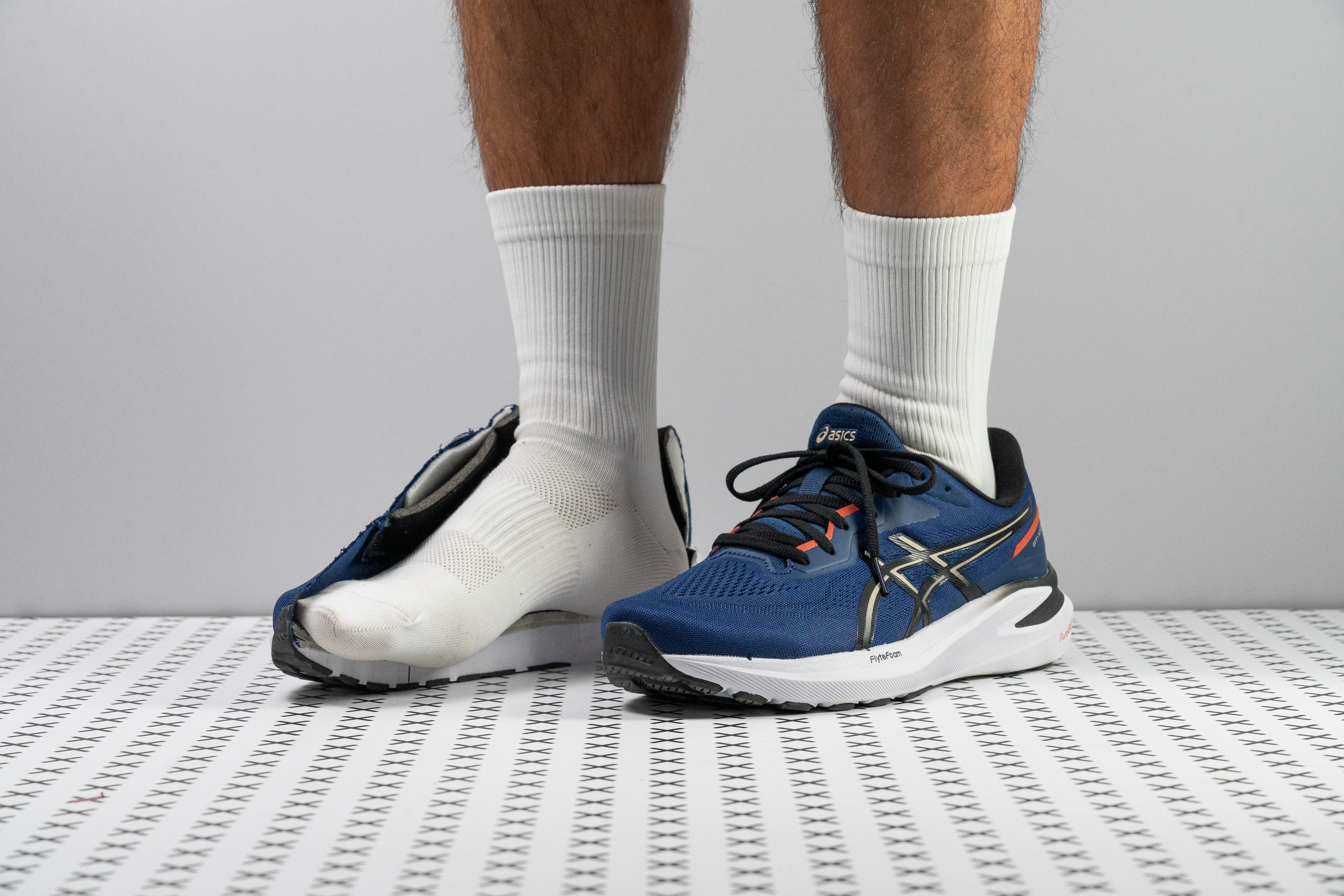Our verdict
- Top pick in best cheap running shoes (2024)
Pros
- Enhanced overall comfort
- PureGEL technology for softer landings
- Durable outsole
- Ready for long runs
- Doubles for walking or gym sessions
- Enhanced for heel strikers
- Reasonable weight
- Reasonable weight
- Reasonable weight
Cons
- Price increase
- Lacklustre bounce
- Breathability downgrade
- Grip has room for improvement
Audience verdict
Comparison
The most similar running shoes compared
+ + Add a shoe | |||||
|---|---|---|---|---|---|
| Audience score | 79 Good! | 89 Great! | 83 Good! | 81 Good! | |
| Price | £115 | £130 | £160 | £115 | |
| Pace | Daily running | Daily running | Daily running | Daily running | |
| Shock absorption | Moderate | Moderate | Low | Moderate | |
| Energy return | Low | High | Low | Low | |
| Traction | Moderate | Moderate | Moderate | High | |
| Arch support | Stability | Stability | Stability | Stability | |
| Weight lab Weight brand | 9.7 oz / 276g 9.7 oz / 274g | 9.8 oz / 279g 9.8 oz / 278g | 11.6 oz / 329g 11.3 oz / 320g | 9.6 oz / 272g 9.3 oz / 265g | |
| Drop lab Drop brand | 8.7 mm 8.0 mm | 10.0 mm 10.0 mm | 7.9 mm 10.0 mm | 9.6 mm 8.0 mm | |
| Strike pattern | HeelMid/forefoot | HeelMid/forefoot | Mid/forefoot | HeelMid/forefoot | |
| Size | True to size | True to size | True to size | Slightly small | |
| Midsole softness | Balanced | Balanced | Balanced | Soft | |
| Difference in midsole softness in cold | Small | Small | Normal | Normal | |
| Toebox durability | Decent | Decent | Good | Decent | |
| Heel padding durability | Good | Bad | Good | Good | |
| Outsole durability | Good | Decent | Good | Good | |
| Breathability | Moderate | Moderate | Moderate | Warm | |
| Width / fit | Medium | Medium | Narrow | Medium | |
| Toebox width | Medium | Wide | Medium | Medium | |
| Stiffness | Moderate | Flexible | Moderate | Moderate | |
| Torsional rigidity | Stiff | Moderate | Stiff | Stiff | |
| Heel counter stiffness | Stiff | Stiff | Moderate | Moderate | |
| Heel lab Heel brand | 33.7 mm 36.0 mm | 33.1 mm 36.0 mm | 33.2 mm 31.0 mm | 35.4 mm 34.5 mm | |
| Forefoot lab Forefoot brand | 25.0 mm 28.0 mm | 23.1 mm 26.0 mm | 25.3 mm 21.0 mm | 25.8 mm 26.5 mm | |
| Widths available | NormalWideX-Wide | Normal | Normal | NormalWideX-Wide | |
| Orthotic friendly | ✓ | ✓ | ✓ | ✓ | |
| Season | All seasons | All seasons | All seasons | All seasons | |
| Removable insole | ✓ | ✓ | ✓ | ✓ | |
| Ranking | #601 Bottom 9% | #111 Top 30% | #252 Bottom 32% | #302 Bottom 19% | |
| Popularity | #310 Top 47% | #259 Bottom 30% | #159 Top 43% | #153 Top 41% |
Who should buy
We've rigorously tested the ASICS GT 1000 13 and we're convinced it's an exceptional choice for:
- Runners with just over £100 to spend who desire a shoe that’s stable, durable, and comfortable—perfect for daily training!
- Fans of the GT 1000 series who will find this version to be among the best yet, now featuring the PureGEL technology.
- Heel strikers looking for moderate support in a shoe versatile enough for grocery shopping and dog walking.

Who should NOT buy
We found that the GT 1000 13 falls a bit short for runners seeking a bouncy ride. The FlyteFoam midsole, lacking energy return, may disappoint those who prioritise responsiveness during their runs.
For a similar shoe with enhanced foam, we recommend considering the ASICS GT 2000 12. And if you are willing to get the best stability shoe from ASICS, check the Kayano 31. Both shoes incorporate the more responsive FF Blast+ along with PureGEL technology.
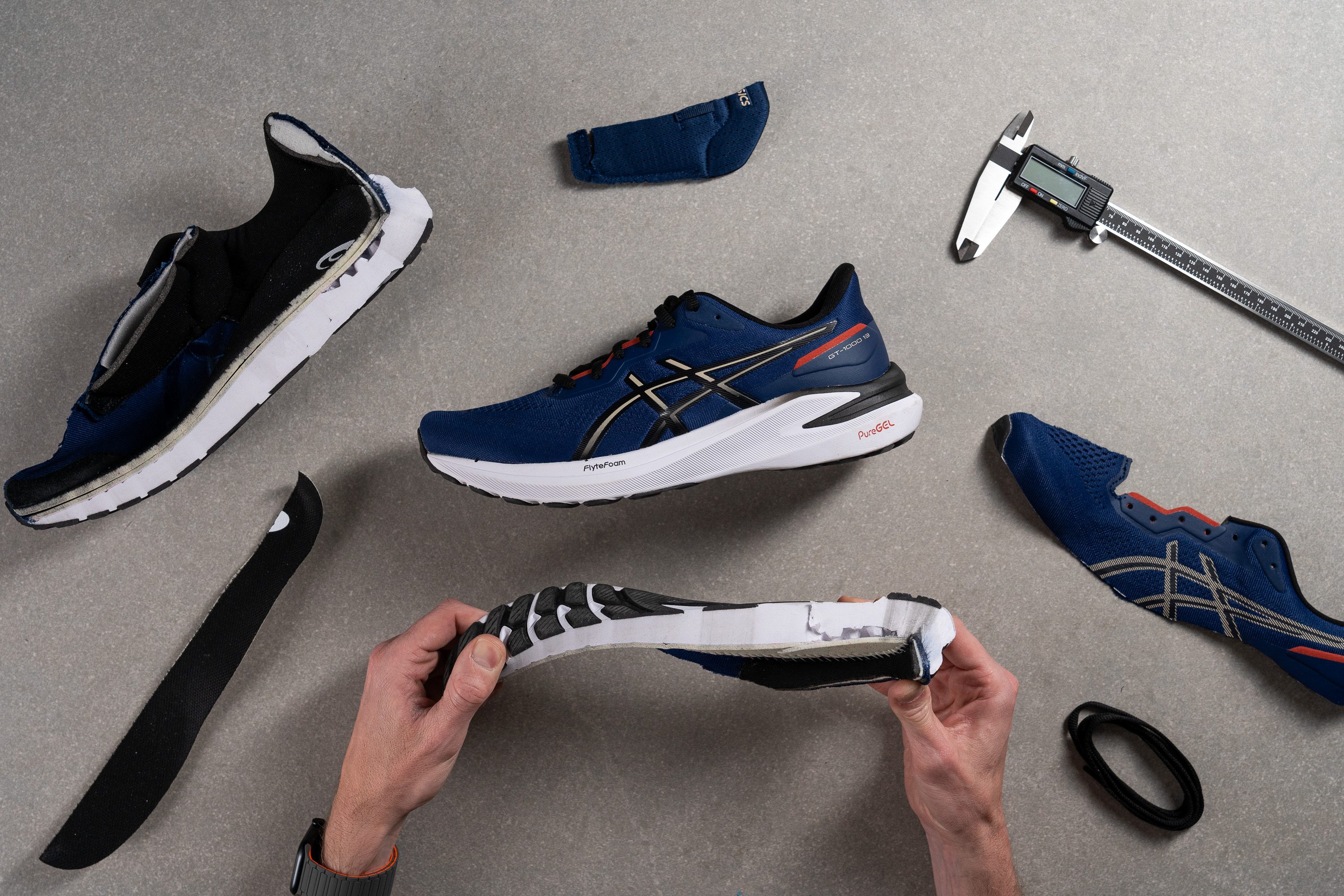
We also believe that for runners with an extreme heel-striking technique, the GT 1000 13 might not offer the best geometry due to its medium drop. In our experience, the Brooks Launch 10, featuring a significant 12.2 mm offset, is a better choice for them.
Cushioning
Shock absorption
We pointed out the lack of impact dampening in the previous GT 1000, and ASICS thankfully addressed it. We found improved scores—116 SA in the heel and 96 SA in the forefoot. Still below average, but expected considering this shoe’s spot in the ASICS lineup.
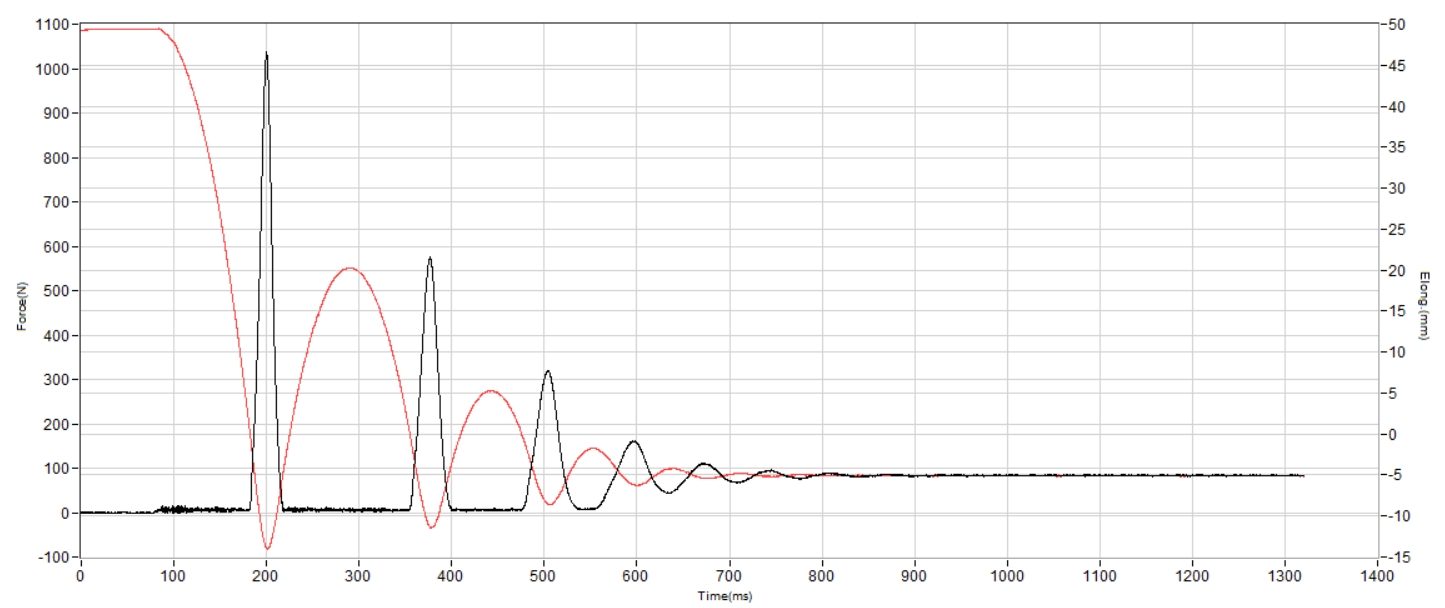
| GT 1000 13 | 116 SA |
| Average | 129 SA |
Energy return
Energy return got a slight upgrade. Using our testing machine, we found that the GT 1000 13 now delivers 48.0%. And we can't sugarcoat it—that's still well below average, even if it’s a step up from its predecessor. ASICS has room to improve here.
| GT 1000 13 | 48.0% |
| Average | 58.5% |
Heel stack
We've just discussed the increased stack height, and indeed, it's real.
At 33.7 mm, it has risen by 3.5 mm compared to its predecessor. This significant enhancement in cushioning underfoot makes the latest GT 1000 an outstanding choice for heel strikers or those covering long runs, marking it as the best version yet for marathoners.
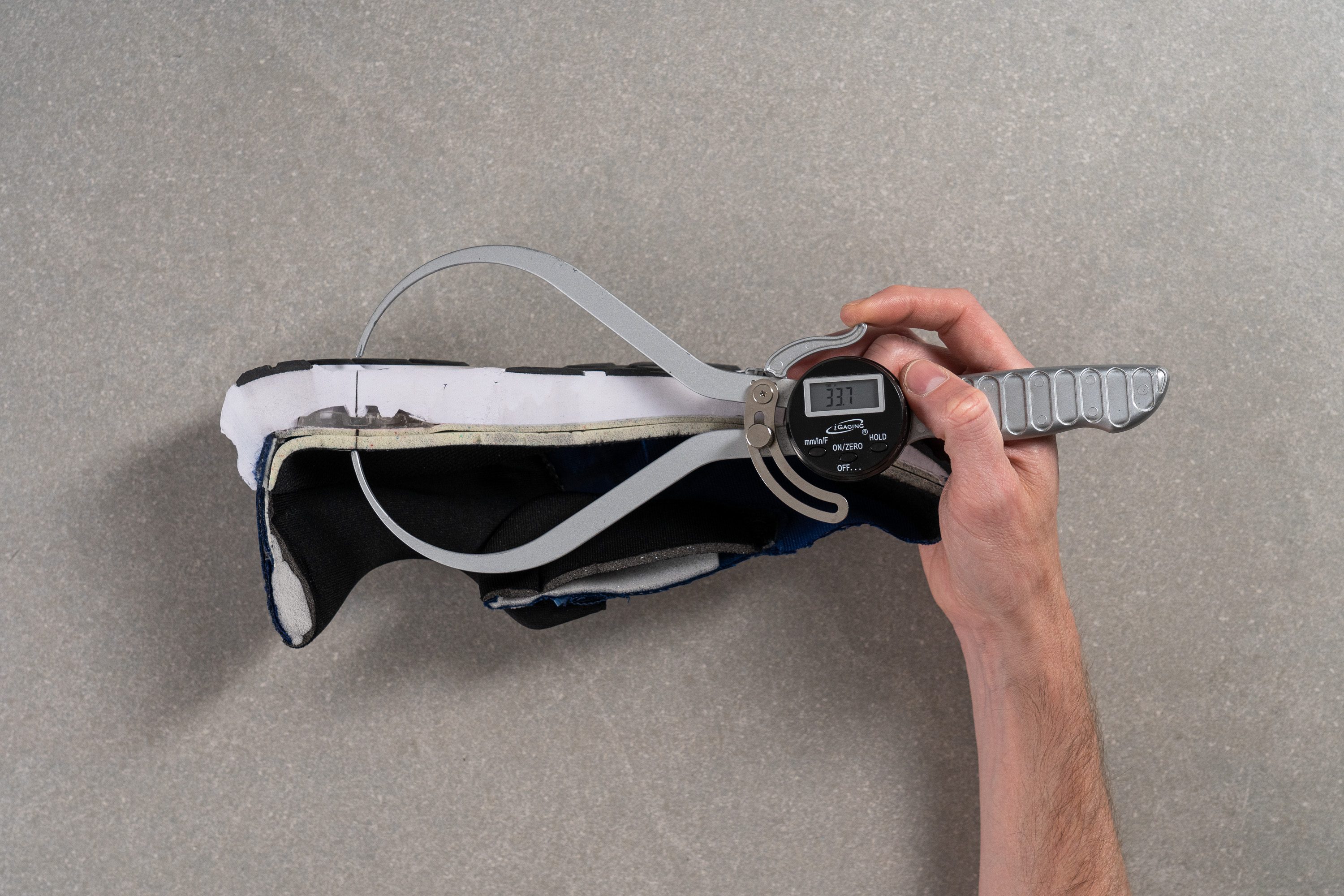
| GT 1000 13 | 33.7 mm |
| Average | 34.8 mm |
Forefoot stack
Previously at 23.0 mm, we found the forefoot also grows to 25.0 mm, providing a more standard level of cushioning that solidifies this shoe's status as an ideal daily trainer.
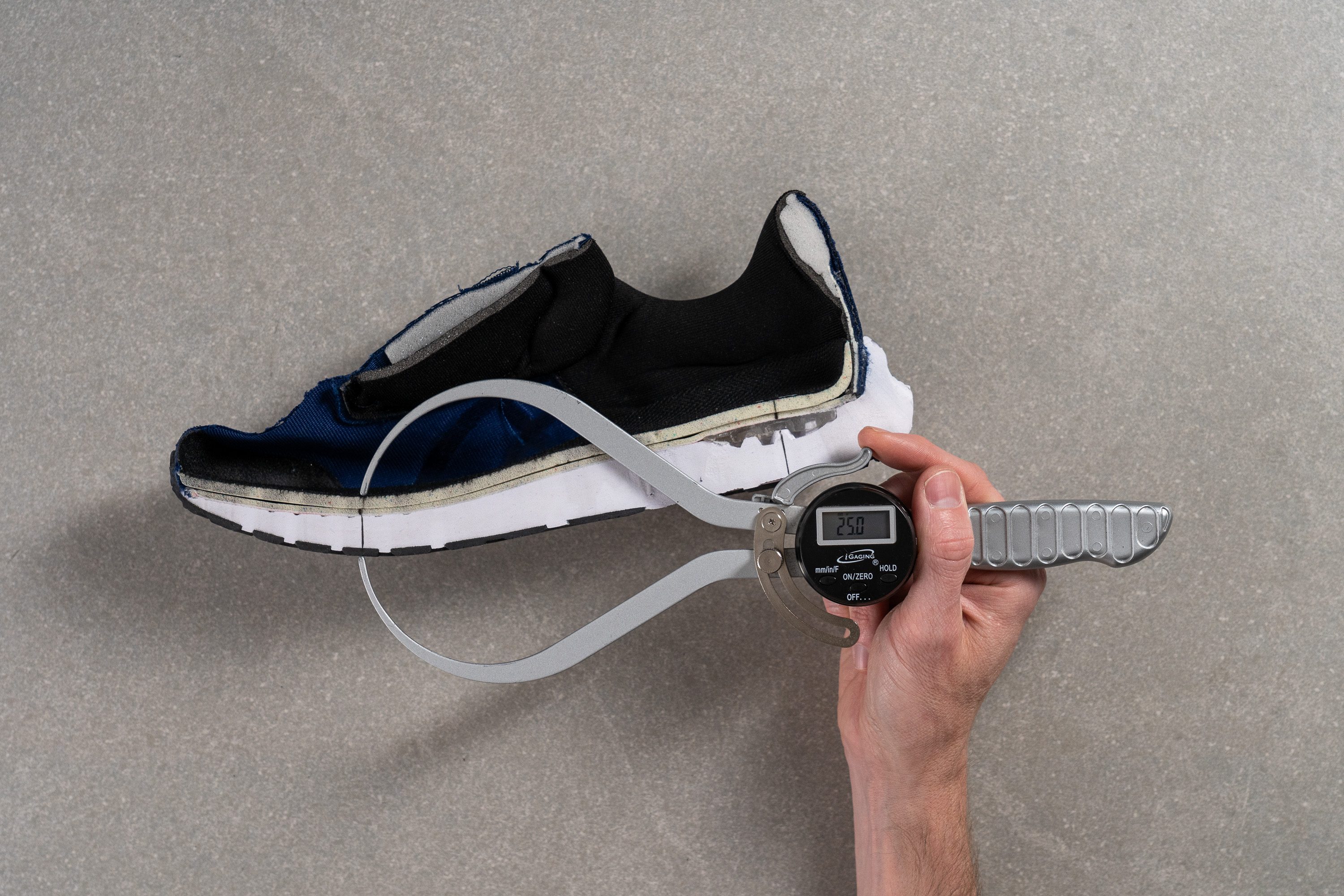
| GT 1000 13 | 25.0 mm |
| Average | 26.2 mm |
Drop
Although it's marketed with an 8 mm offset, our precise stack measurements revealed a slight variation, resulting in an actual heel drop of 8.7 mm. While this variation is minor, it still places the GT 1000 13 within the mid-drop category.
This heel drop offers versatility, accommodating a broad range of runners, from those who strike at the heel to those who favour the midfoot.
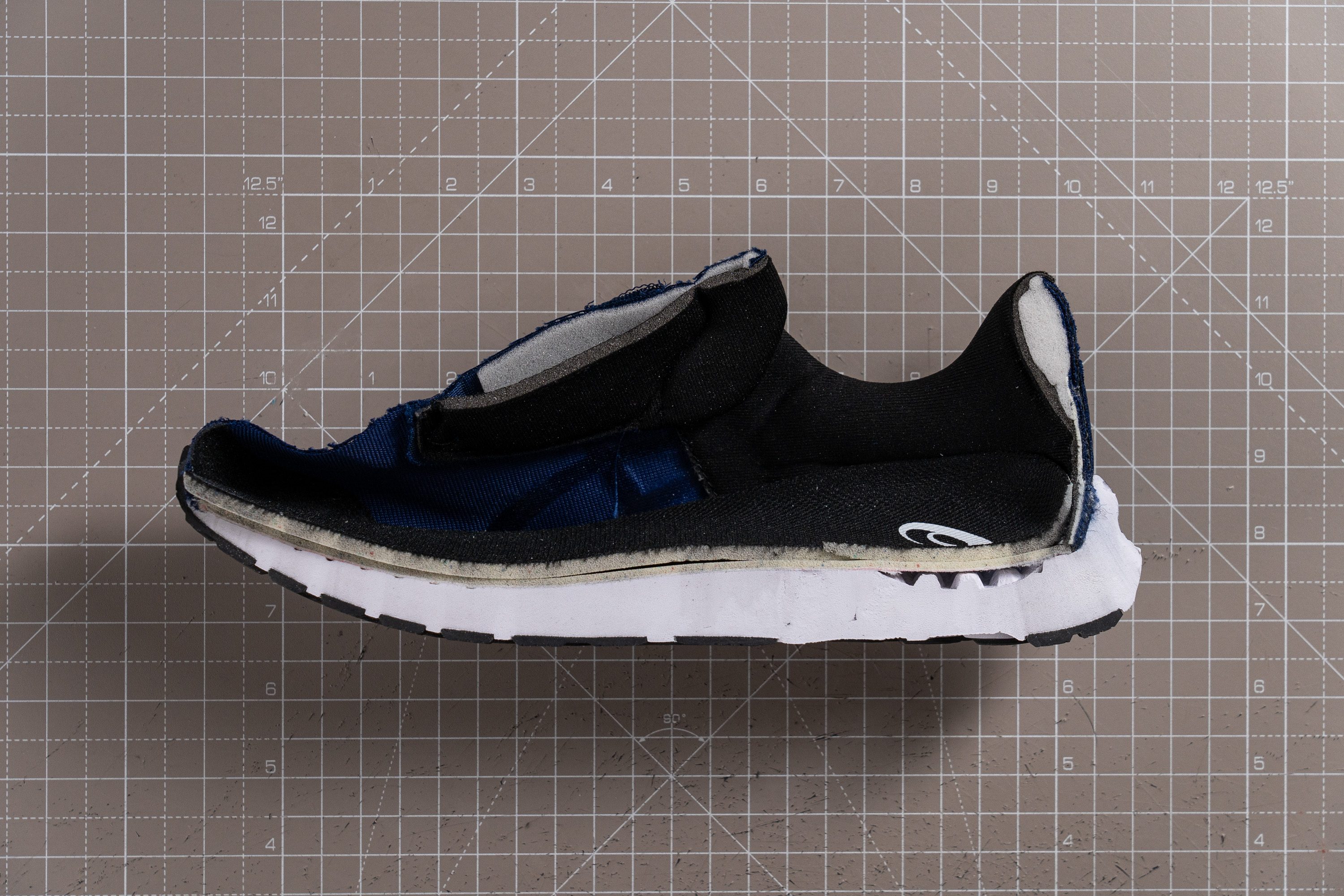
| GT 1000 13 | 8.7 mm |
| Average | 8.6 mm |
Midsole softness
There are no significant changes to the foam in this update, as ASICS continues to reserve its top-tier compounds like FF Blast+ for pricier models like the Novablast 4. Instead, we still have Flytefoam, an EVA-based foam that performs adequately given the price of this shoe.
With a softness score of 22.5 HA, the foam offers a balanced ride, although it may feel firm to those transitioning from a plusher model. However, we believe this firmness is appropriate for a mild stability shoe like this one.
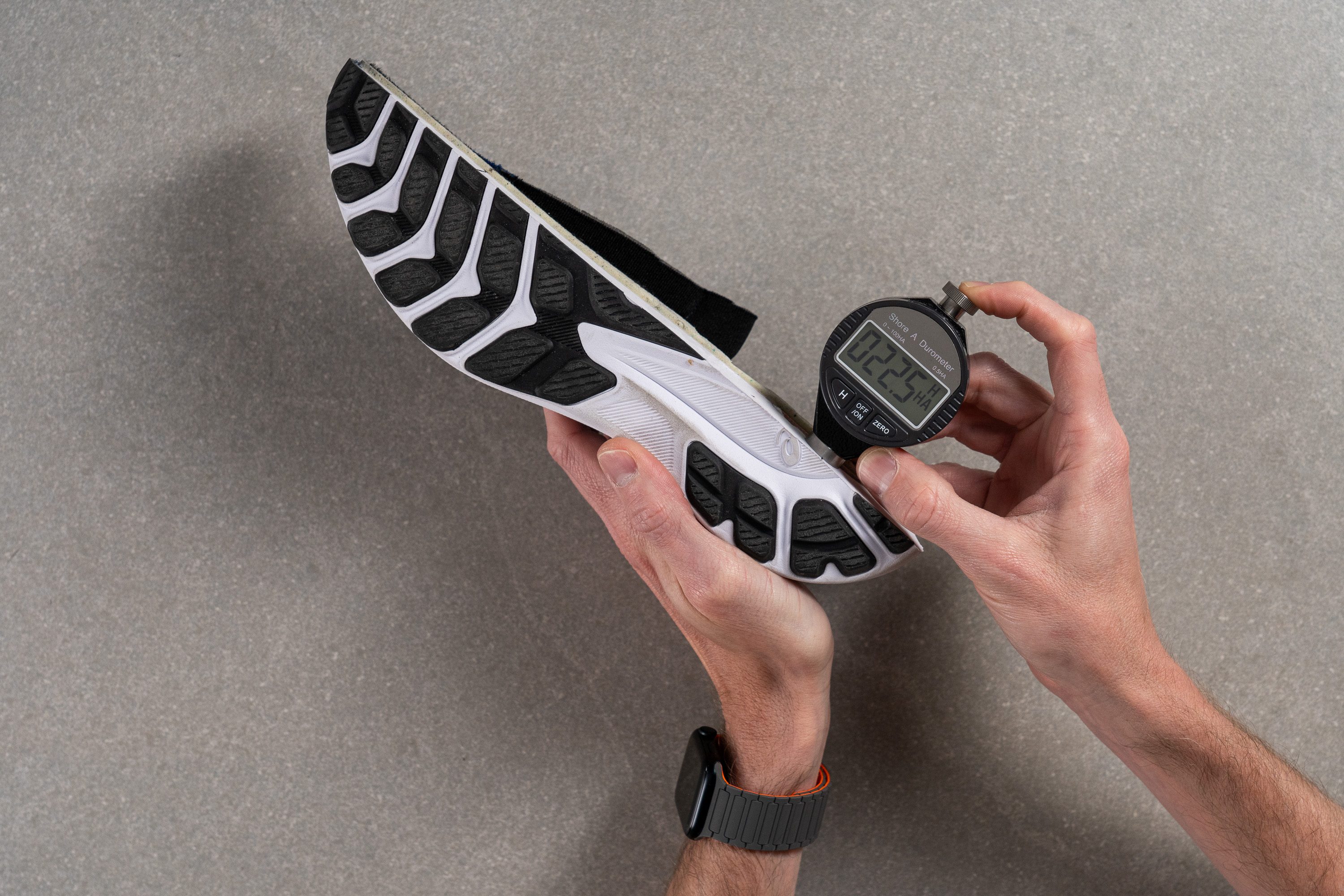
| GT 1000 13 | 22.5 HA |
| Average | 20.4 HA |
Rocker
The GT 1000 13 offers a traditional ride, steering clear of the more recent rockered designs, and we believe this is the perfect approach for a daily trainer like this.
PureGEL
The key incentive to upgrade from the GT 1000 12 to the 13 is the introduction of PureGEL. This evolution of GEL technology, now positioned directly under the footbed rather than in the lower part of the shoe, enhances underfoot comfort and reduces the energy-return losses typical of the older GEL.
Designed to ensure exceptionally soft landings, it's designed for heel strikers. Our testing confirmed that it indeed delivers a highly comfortable impact. However, it still reduces energy return when compared even to standard EVA foams.
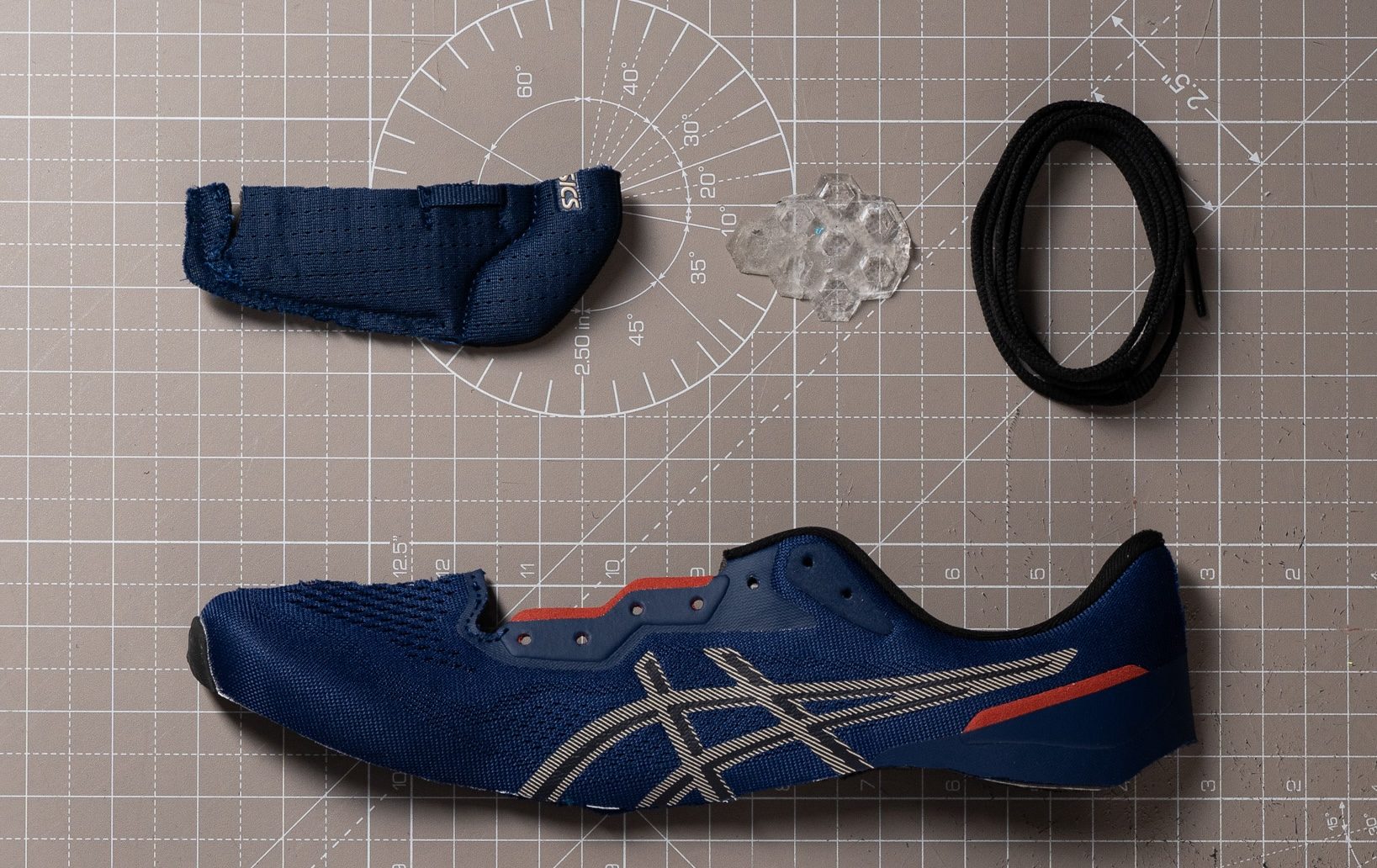
Size and fit
Size
ASICS GT 1000 13 fits true to size (45 votes).
Width / Fit
At 96.9 mm, the widest part of the shoe fits within the average range, though it leans slightly more towards roomy than narrow in our experience running with this shoe.
Therefore, it's clear to us that ASICS aims to accommodate as many feet as possible, especially since they also offer the GT 1000 13 in multiple widths in certain markets.
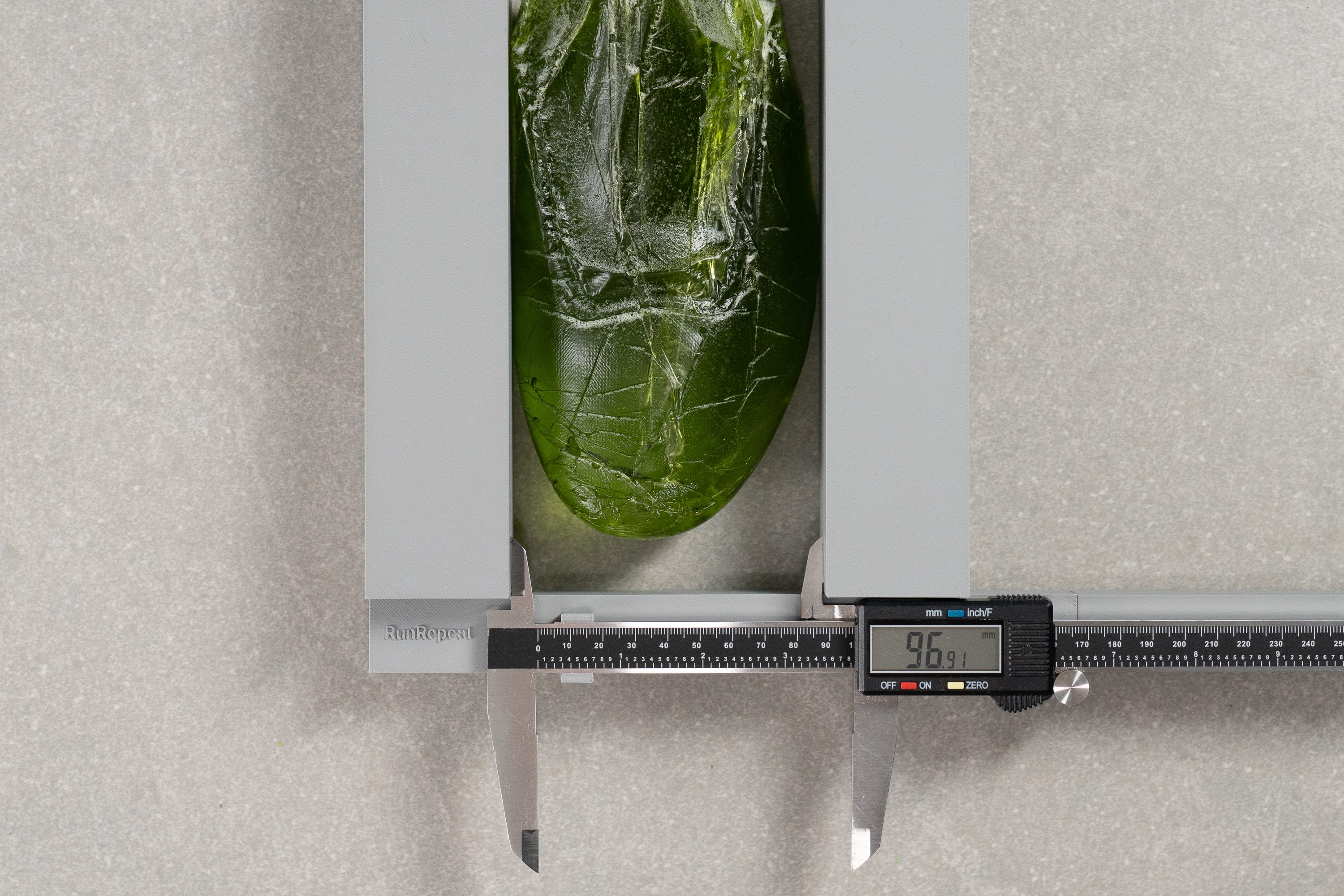
| GT 1000 13 | 96.9 mm |
| Average | 95.1 mm |
Toebox width
The big toe area didn't give us any trouble either. While it's not foot-shaped by any means, the taper meets our expectations for a daily driver at 72.9 mm.
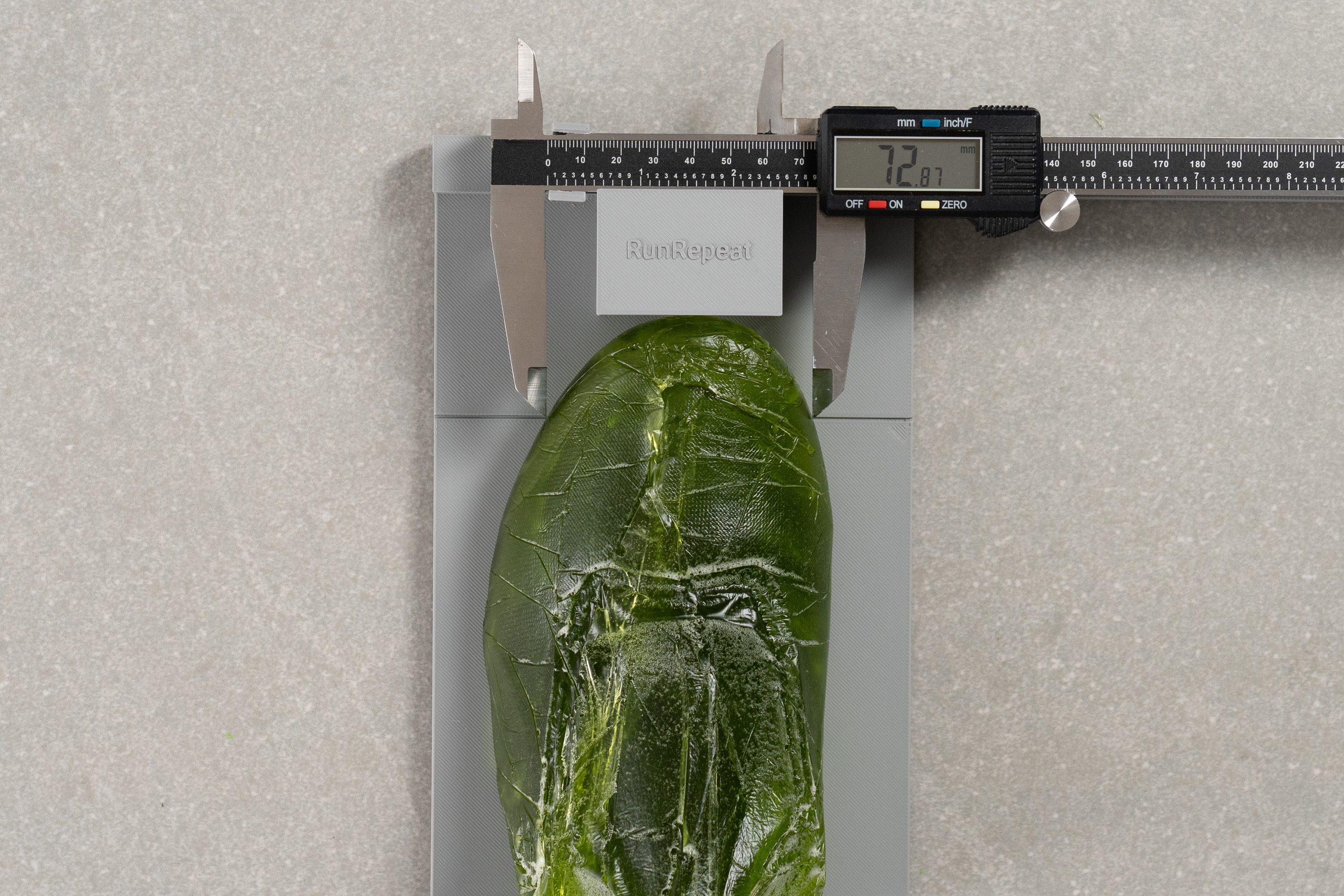
| GT 1000 13 | 72.9 mm |
| Average | 73.2 mm |
Toebox height
And what about vertical space? Our measurement showed 26.7 mm, which should prevent most issues, though runners who tend to point their big toe upward might experience slight restrictions.
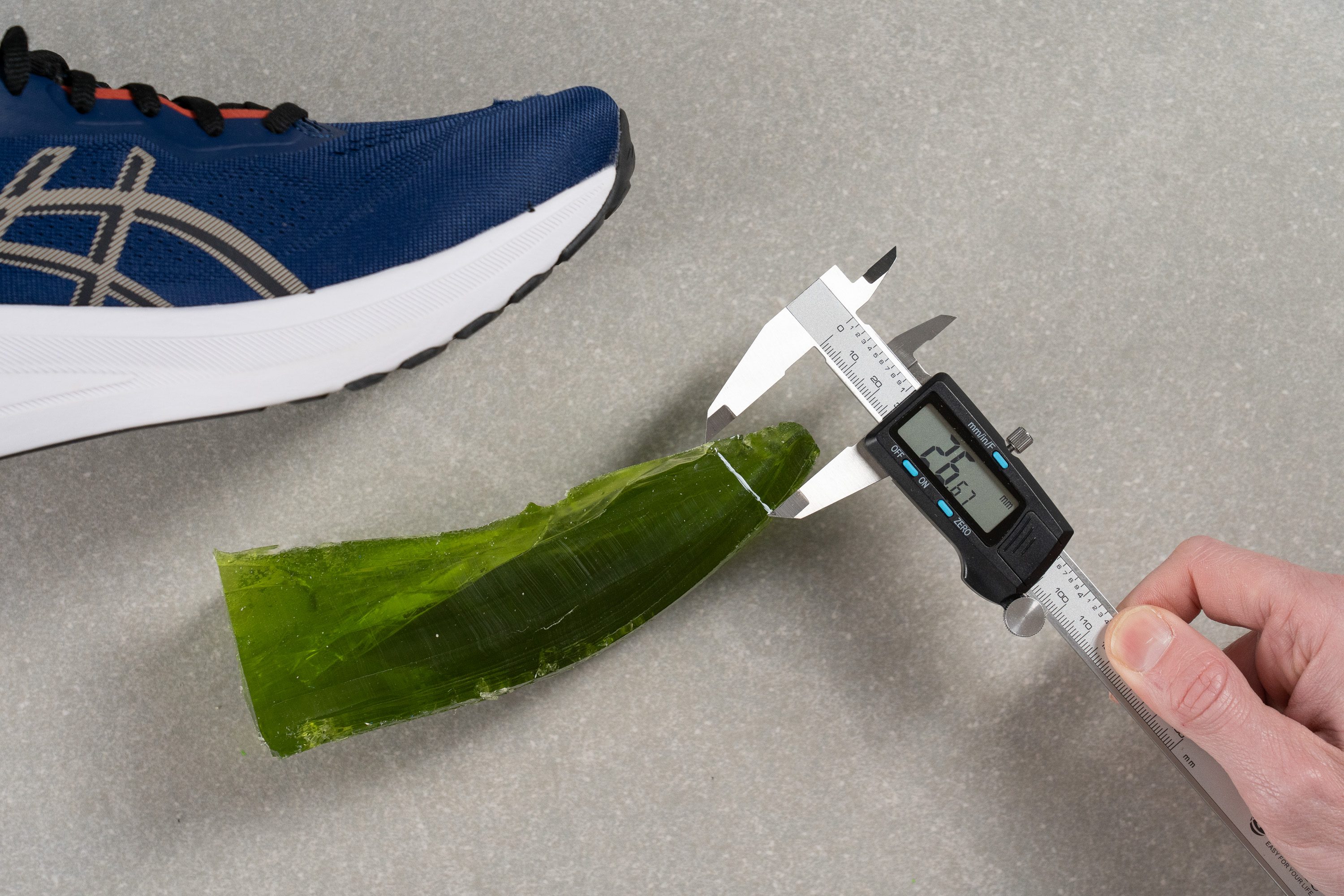
| GT 1000 13 | 26.7 mm |
| Average | 27.1 mm |
Traction / Grip
Traction test
We tested the outsole on our wet slab of pavement and weren’t shocked by the 0.35 score—it closely mirrors the previous version, which also underperformed on rainy surfaces. The recycled outsole design left no room for surprises.
While the shoe provides decent grip on dry ground, its low-friction compound and average-coverage layout leave noticeable room for improvement when conditions turn slick.
| GT 1000 13 | 0.35 |
| Average | 0.48 |
Outsole design
The outsole features a structured layout with several flex grooves and targeted rubber zones across high-stress areas—ideal for supporting runners with pronation concerns. We also found that ASICS incorporated AHAR, a high-durability compound known for its long-lasting properties.
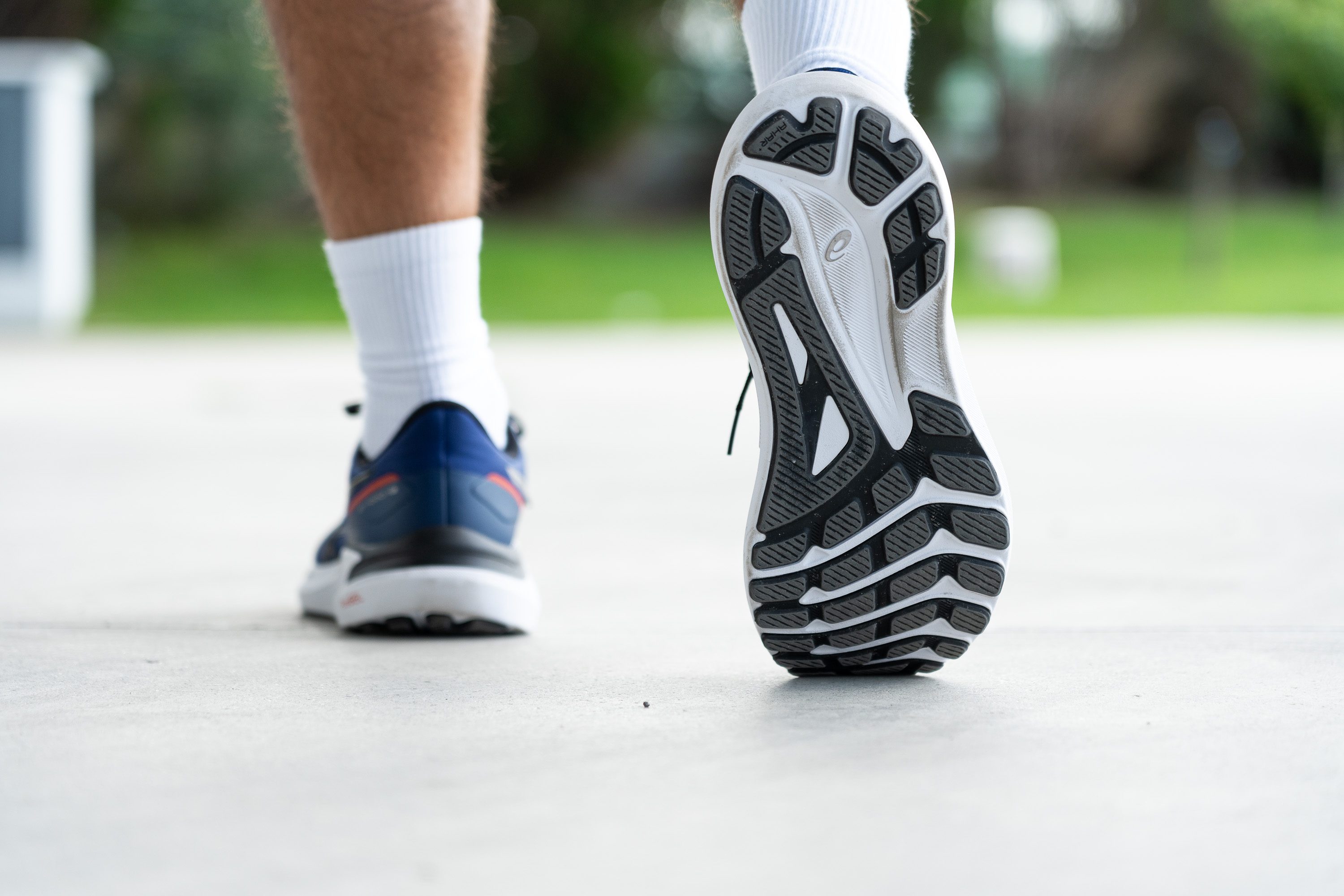
Flexibility / Stiffness
This shoe is designed to be a jack-of-all-trades, capable of handling everyday tasks beyond running, which means it requires flexibility.
In our lab, we needed to apply only 11.4N of force to bend it to the 30-degree mark. This result perfectly aligns with what we were hoping to find!
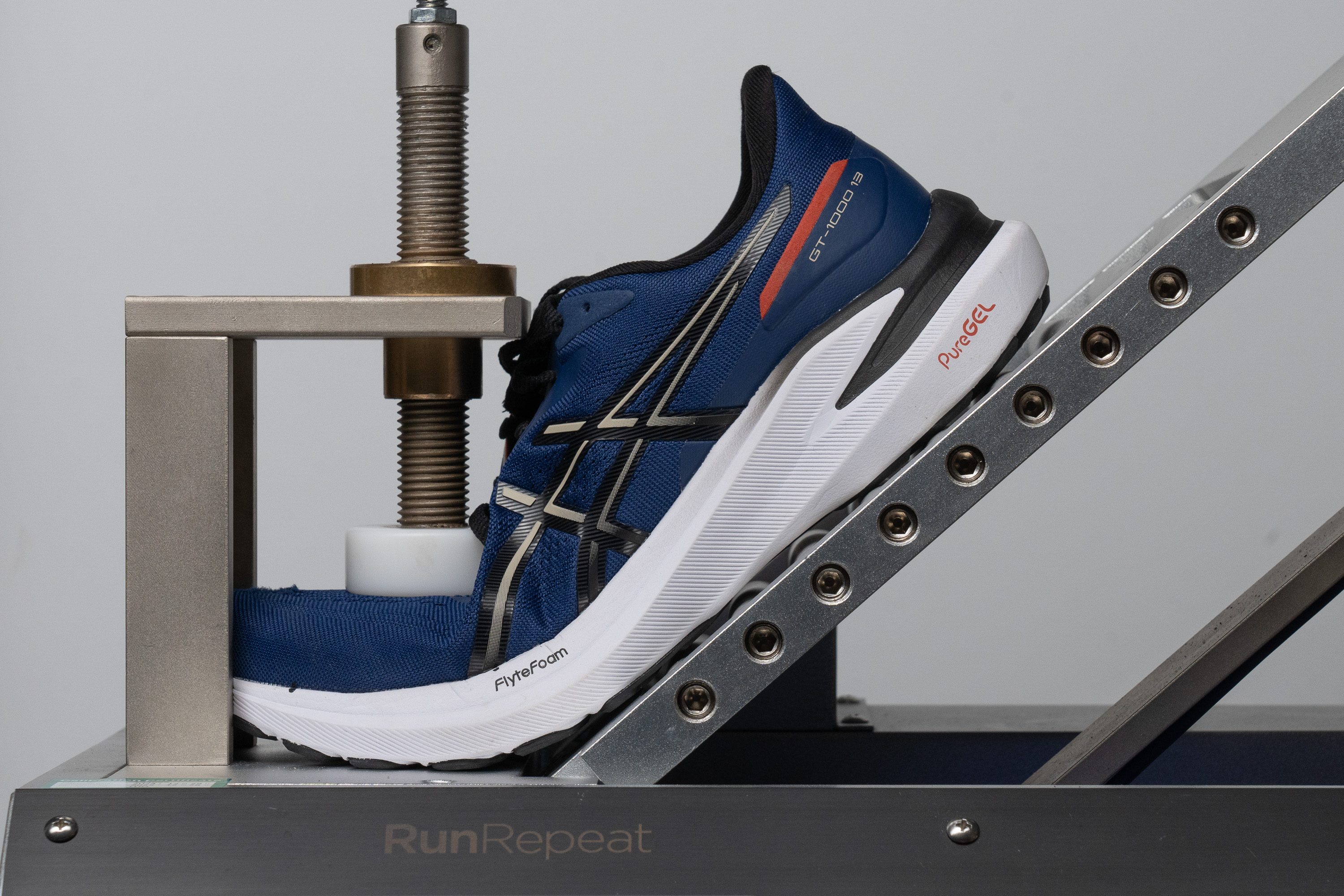
| GT 1000 13 | 11.4N |
| Average | 15.3N |
Stiffness in cold (%)
Just as we observed with the midsole softness, FlyteFoam delivered another impressive performance in terms of longitudinal stiffness, showing only a 19.7% variation. This is a clear improvement over results from much pricier shoes.
| GT 1000 13 | 20% |
| Average | 33% |
Weight
One of the standout features of the GT 1000 series is its reasonable weight. We discovered that ASICS, despite the stack height increase, has successfully maintained the weight nearly identical to last year's, at just 9.7 oz or 276g.
This is particularly nice for a shoe that boasts substantial rubber in the outsole and ample cushioning underfoot, making it an excellent choice for those seeking a lightweight yet robust running shoe.
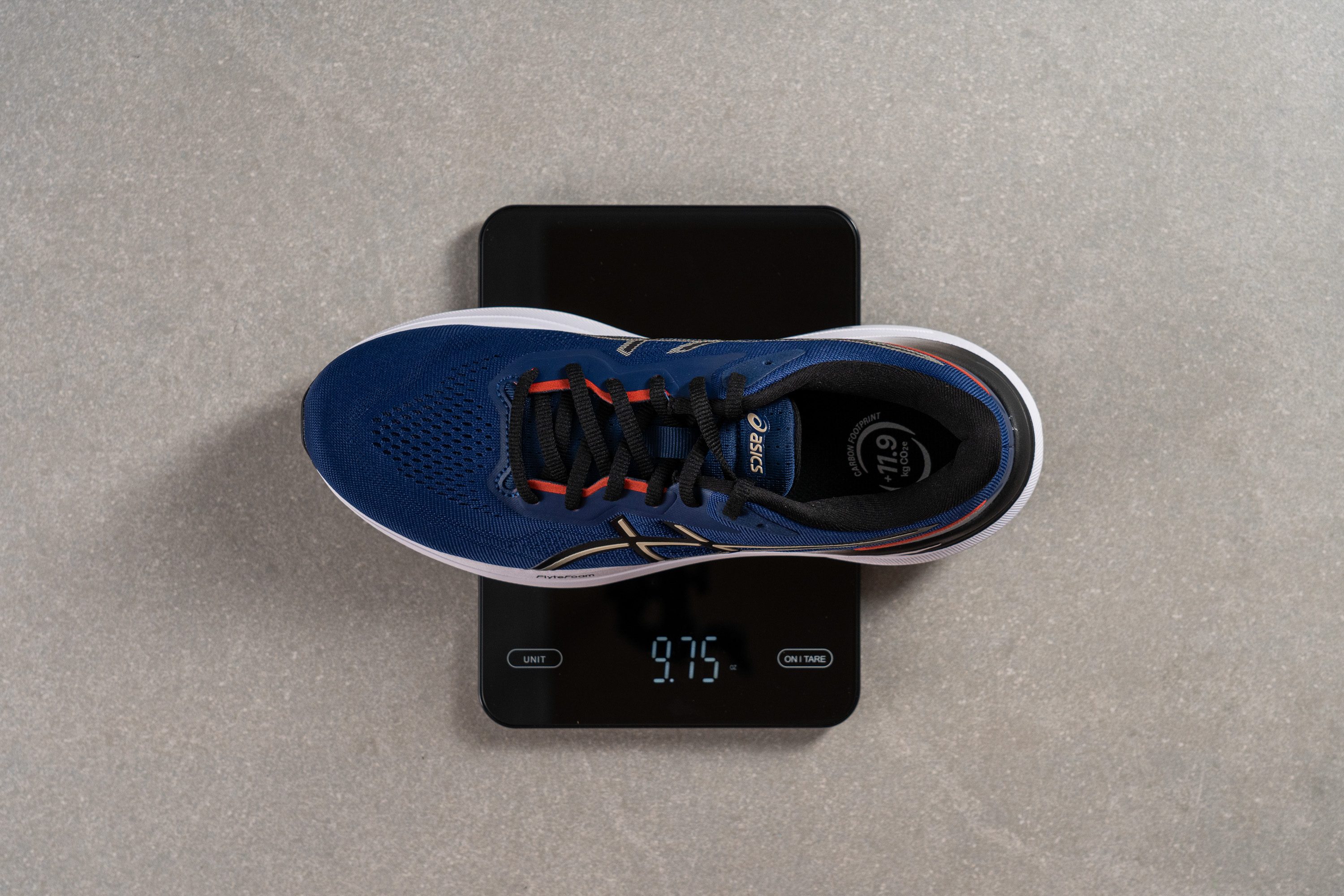
| GT 1000 13 | 9.7 oz (276g) |
| Average | 9.3 oz (264g) |
Breathability
Despite having just minor changes in the upper, we found that breathability suffered slightly with this update.
Following our smoke test, we observed reduced airflow compared to previous versions, leading us to rate it 3 out of 5 in the lab. While not a dismal score—it ensures comfort in most conditions and enhanced performance in cooler weather—it does feel to us like a step down from the previous version's 5/5.
Why the change? We think there are several factors, but primarily, we found the focus was on enhancing durability, which was a significant weakness of the GT 1000 12 (we'll explore this aspect in a minute). We also noted with the light that ASICS focused on designing a thicker upper for improved comfort and stability, particularly around the midfoot.
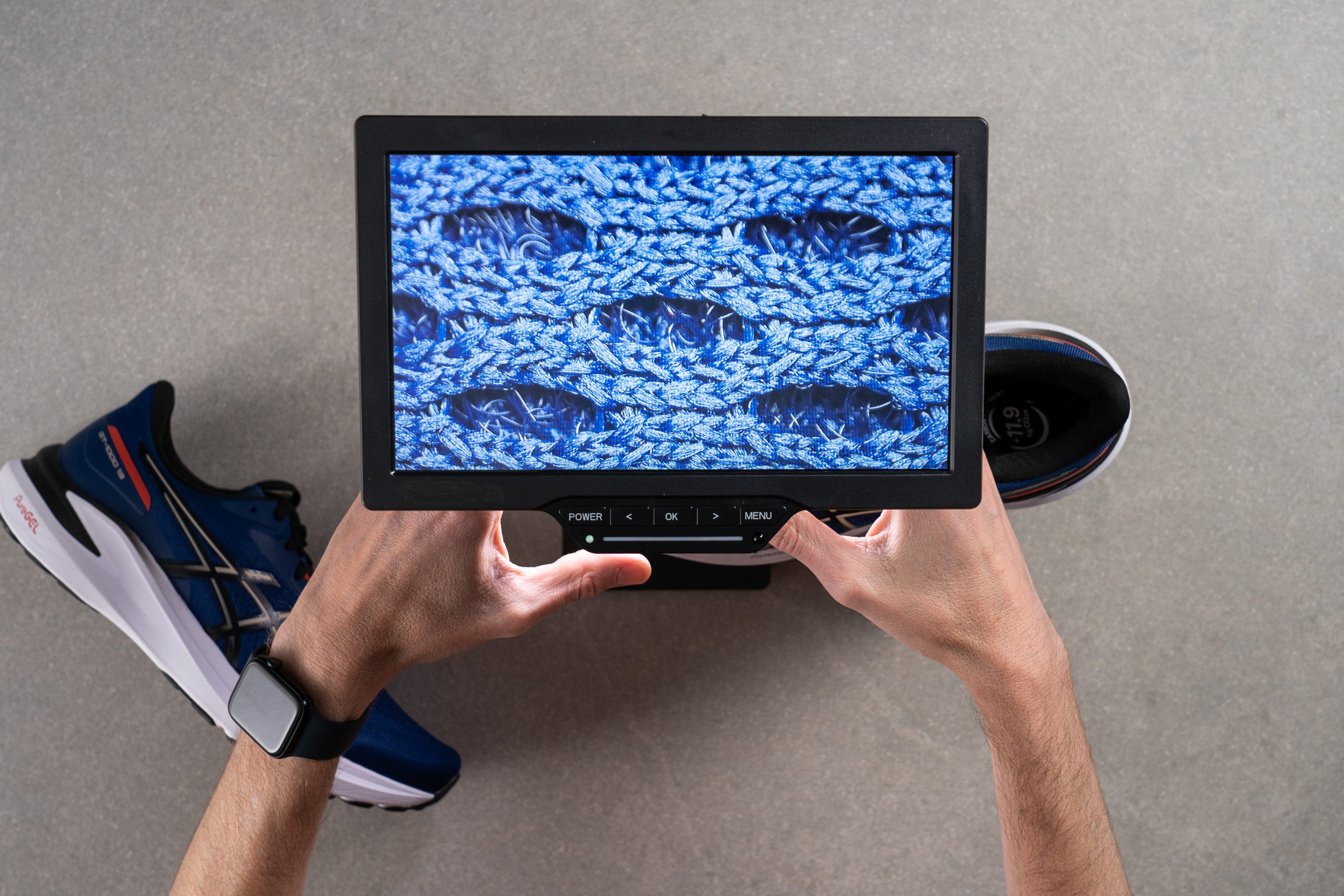
Examining the shoe under our microscope, we identified a densely engineered mesh that includes ventilation holes. However, these are obstructed by an underneath fabric layer, restricting air movement from inside to outside the shoe.

It's worth mentioning that the upper boasts exceptional padding, and the materials are comparable to those found in more expensive daily trainers.
Although airflow has decreased, we think this update compensates with several other enhancements.
| GT 1000 13 | 3 |
| Average | 3.7 |
Stability
Lateral stability test
The ASICS GT 1000 13 introduces some impressive stability features, subtly enhancing the ride for those requiring moderate support—at a fair price.
We identified non-intrusive elements similar to those in the GT 2000 series and the Kayano, albeit a bit toned down. This model incorporates a 3D guidance system with enhanced arch support, elevated midsole sidewalls, a rigid overall build, and a wide heel to create a balanced and supportive ride.
Torsional rigidity
We assigned the GT 1000 13 a score of 4 out of 5 for torsional rigidity, which significantly contributes to its stability features. Much of this structural stiffness is due to the heel reinforcements, a characteristic commonly found in ASICS stability footwear.
This boost from a 3/5 rating in the v12 to a higher score in this version makes sense, as it features a higher stack height that needs to be compensated.
| GT 1000 13 | 4 |
| Average | 3.5 |
Heel counter stiffness
ASICS avoided going overboard but still managed to preserve a significant level of comfort, leading us to give it a rating of 4 out of 5. Although the heel is quite rigid—as our video demonstrates—it remains surprisingly flexible for a stability shoe, offering a more adaptable feel than expected.
| GT 1000 13 | 4 |
| Average | 2.9 |
Midsole width - forefoot
We measured the forefoot at 115.6 mm with our callipers, which is fairly average. This wasn't surprising, given that as a beginner-friendly shoe, the emphasis is likely on the heel. Let's see if this holds true.

| GT 1000 13 | 115.6 mm |
| Average | 114.4 mm |
Midsole width - heel
A wider shoe often translates to a more stable ride, right? For those seeking a supportive experience in a mild stability shoe, a broad base is essential.
This is precisely why ASICS designed this shoe to be wider than the typical neutral daily trainer, especially catering to heel strikers who predominantly will purchase this shoe. In our lab, we measured its width at 96.6 mm, way broader when compared to a neutral workhorse Nike Pegasus 41, which measures only 89.2 mm.

| GT 1000 13 | 96.6 mm |
| Average | 90.7 mm |
Durability
Toebox durability
We previously mentioned that durability was a significant concern for ASICS, especially since the predecessor of this shoe received a teeth-grinding 1 out of 5 in our durability tests, clearly lacking in this aspect. So, how did the 13th edition fare?
Well, it still doesn’t perform exceptionally well in our durability tests, but we observed clear signs of improvement and gave it a 2 out of 5.
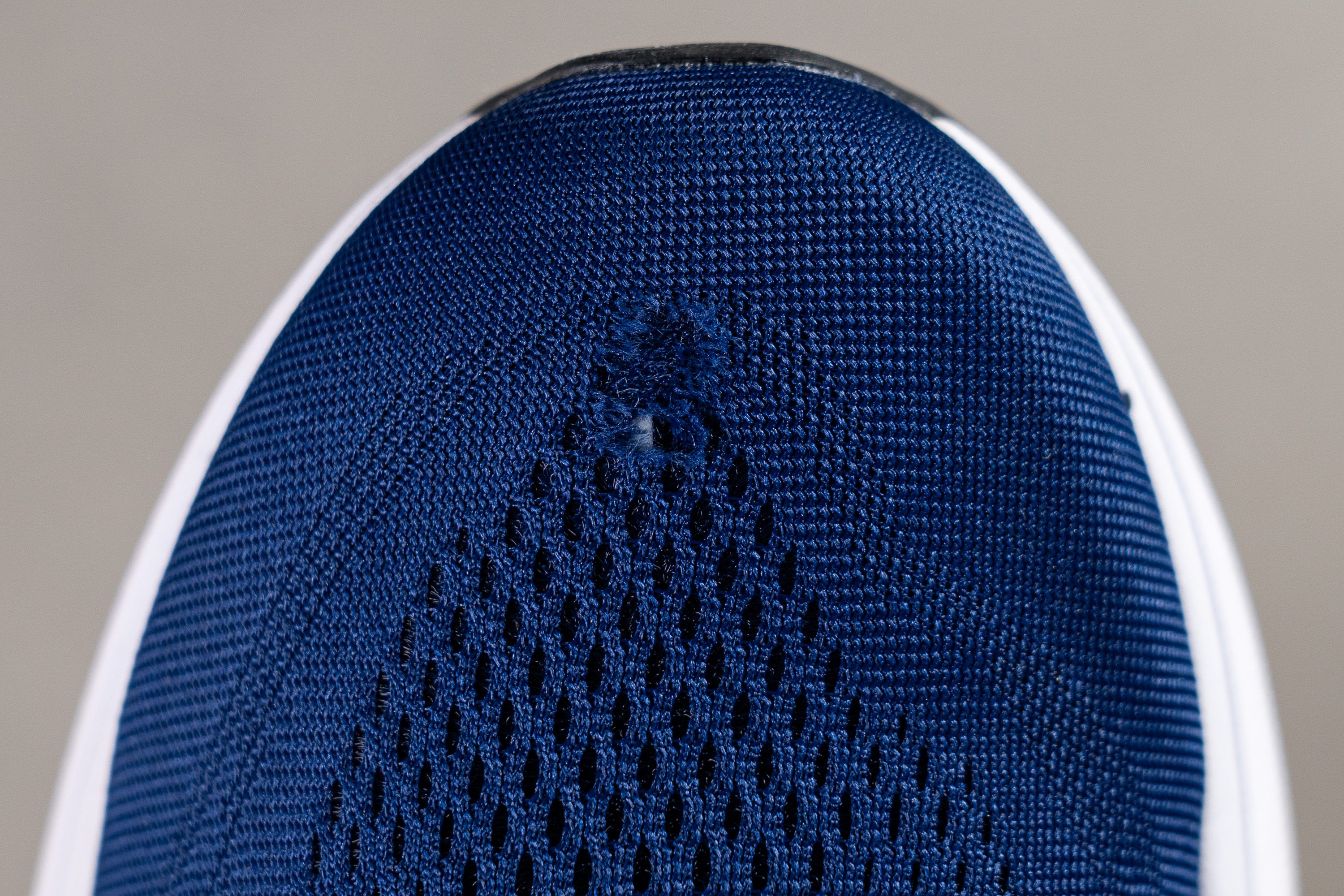
| GT 1000 13 | 2 |
| Average | 2.6 |
Heel padding durability
With the Dremel already set to 5000 RPM, we targeted the heel padding for testing.
In this test, the padding earned a solid 4 out of 5 rating. This result reassures us that the GT 1000 13 are unlikely to experience premature wear in this area.
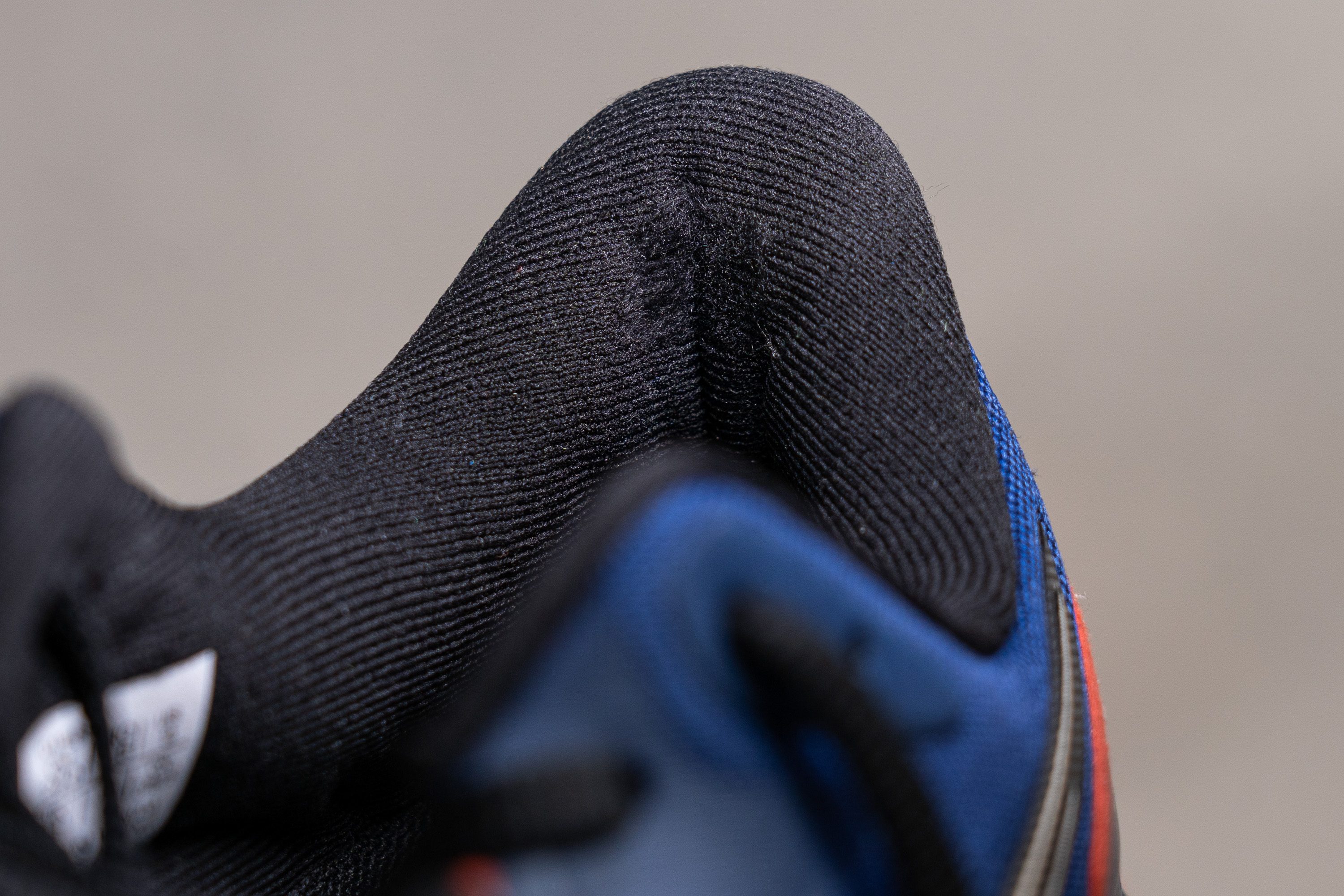
| GT 1000 13 | 4 |
| Average | 3.4 |
Outsole hardness
Interestingly, those looking for budget-friendly shoes often prioritise durability more than runners willing to spend £200 or £300 on their footwear. It's a fascinating paradox, but it's quite typical in the market. We're hopeful that the GT 1000 13, which is designed to be cost-effective, will meet these durability expectations with its outsole.

ASICS has utilised AHAR (ASICS High Abrasion Rubber), renowned for its resilience and hardness (85.1 HC). However, it's worth noting that the grip is not superb at all, especially in wet conditions.

| GT 1000 13 | 85.1 HC |
| Average | 79.2 HC |
Outsole durability
While hard rubbers typically promise excellent outsole durability, we don't just rely on assumptions—we put shoes through rigorous tests here in our lab.
So, we proceeded with our final Dremel test and were thrilled to discover only a minimal 0.7 mm dent in the outsole, which is a good outcome.
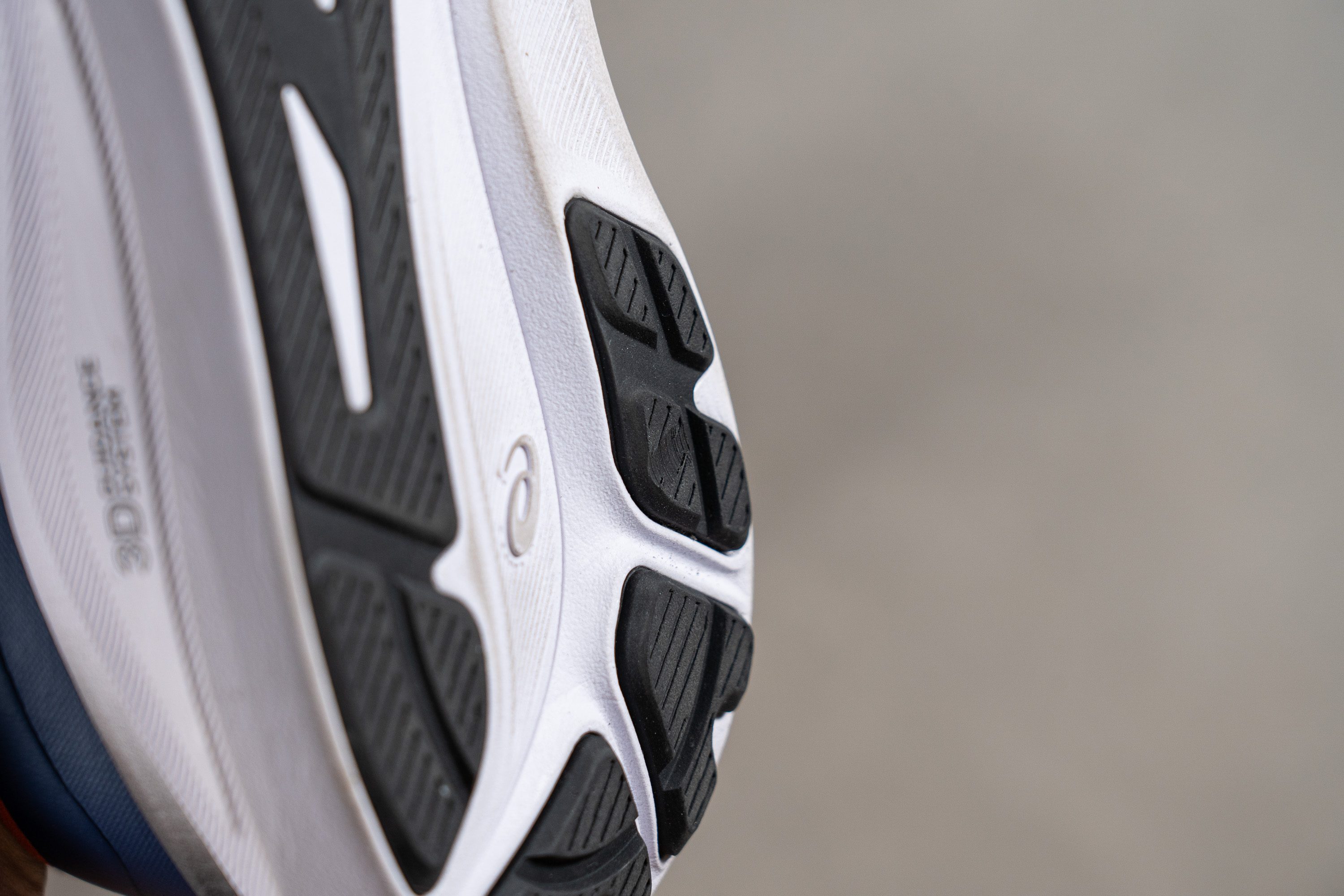
| GT 1000 13 | 0.7 mm |
| Average | 1.1 mm |
Outsole thickness
To conclude our examination of the outsole, we used a vernier calliper to measure its thickness. We noted that ASICS opted for a robust 4.1-mm outsole, a decrease from the previous version's massive 4.8 mm.
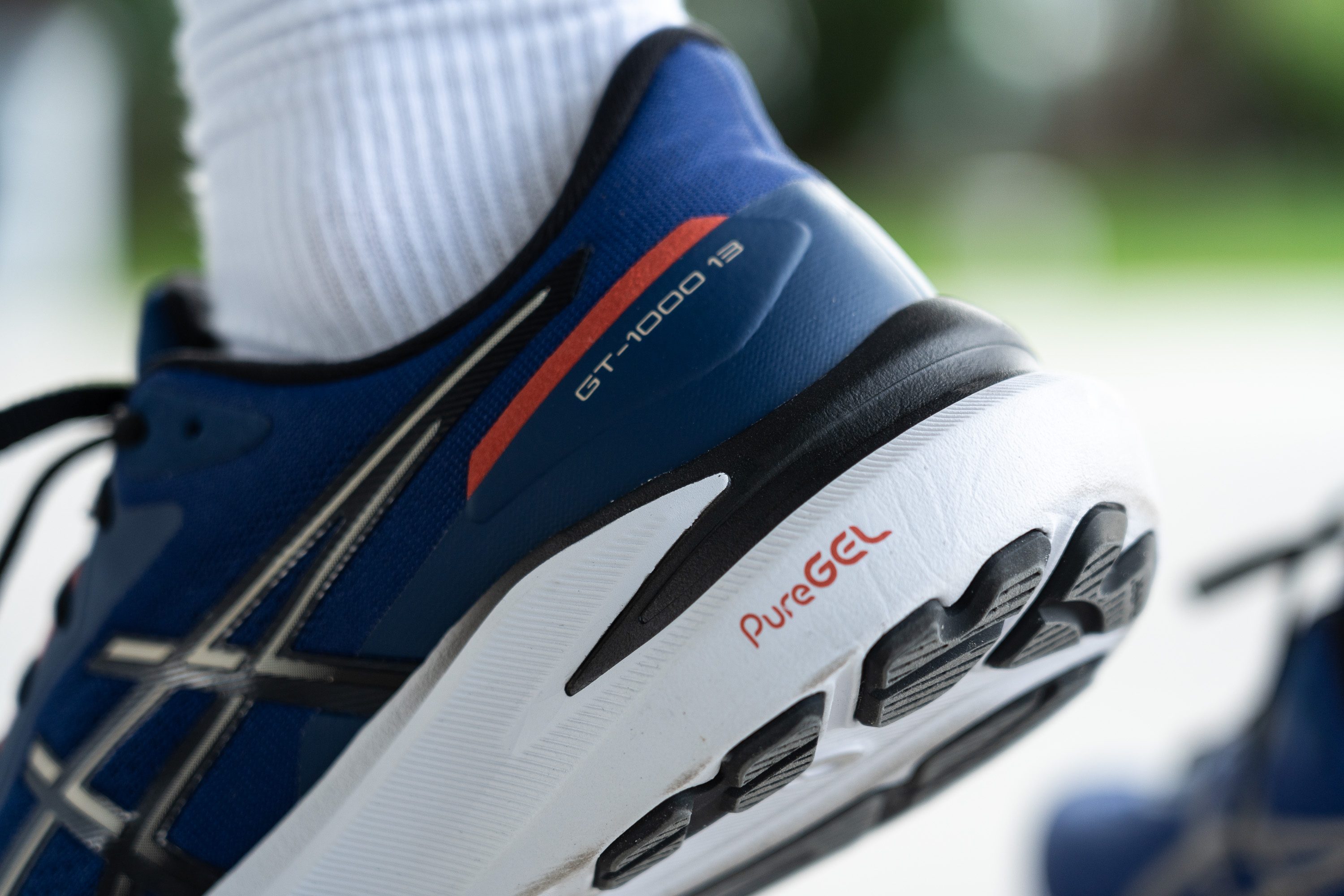
We believe a thinner outsole around 2.5 mm or 3 mm could be beneficial for this shoe. This adjustment would likely reduce the shoe's weight and enhance responsiveness, providing a livelier ride, and still feature enough durability.
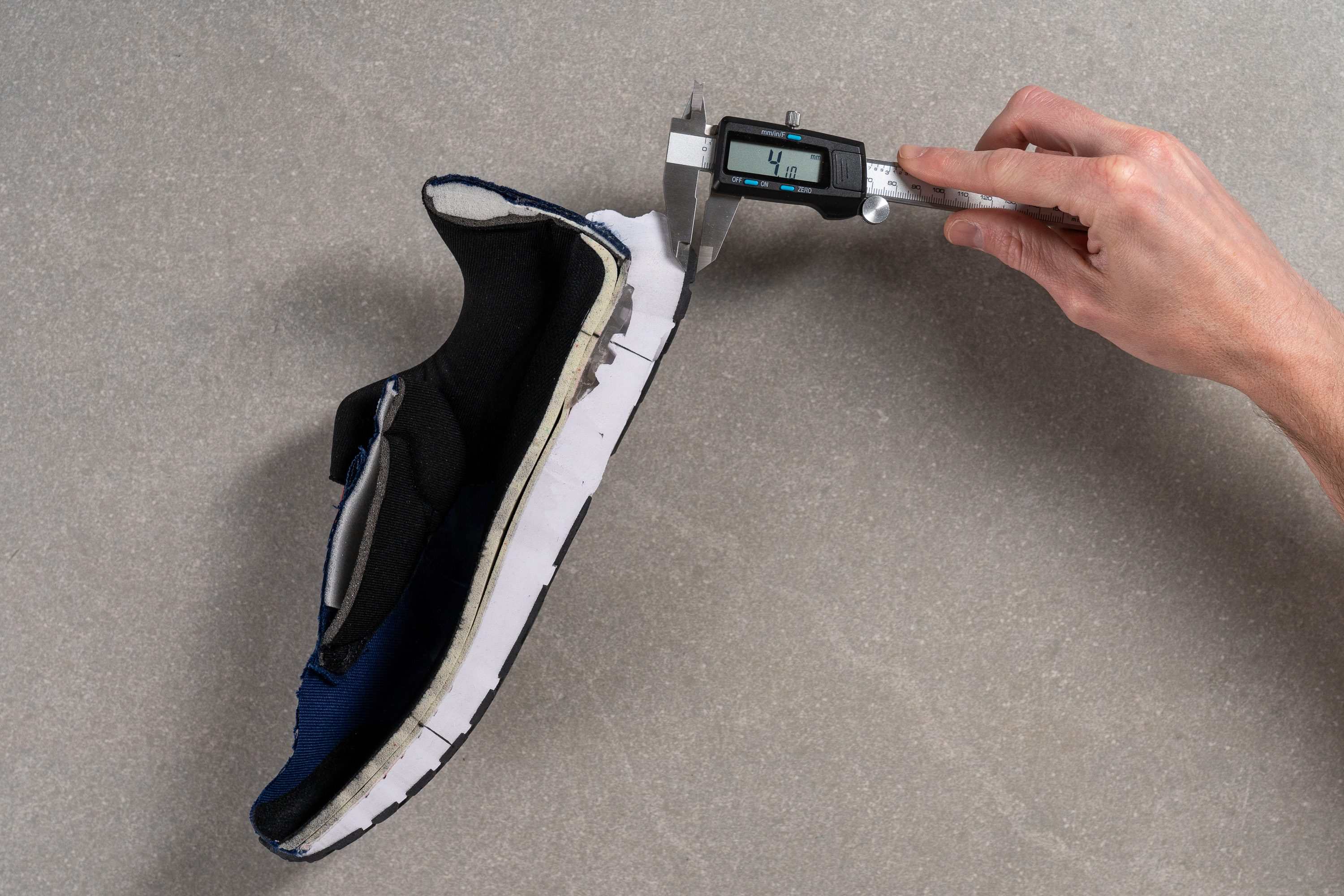
| GT 1000 13 | 4.1 mm |
| Average | 3.2 mm |
Misc
Insole thickness
The EVA insole is just average, measuring just 4.9 mm. It's also worth noting that it's not manufactured by ASICS, but by Ortholite.
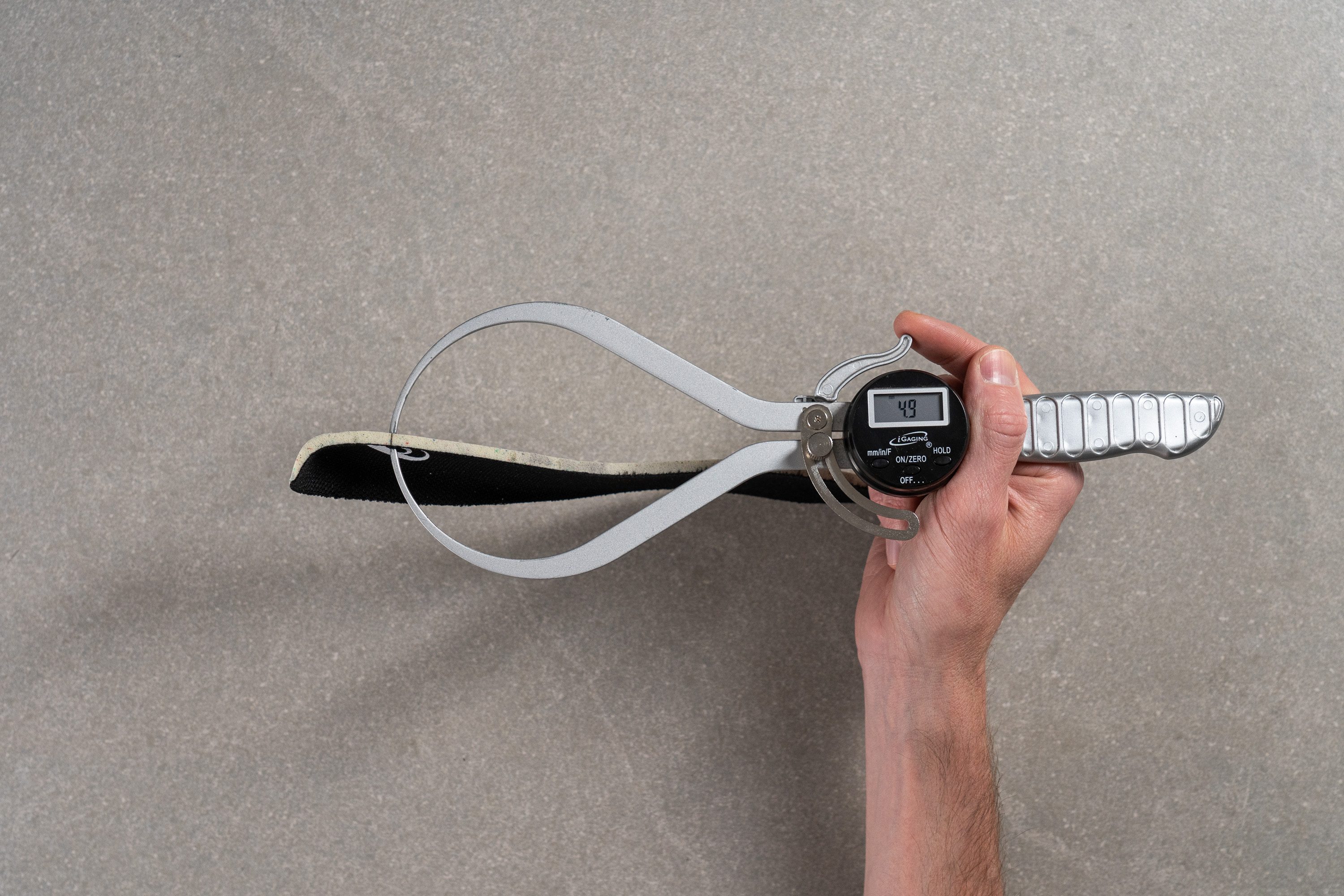
| GT 1000 13 | 4.9 mm |
| Average | 4.5 mm |
Removable insole
We encountered no issues replacing the insole of the GT 1000 13, thanks to its standard size.
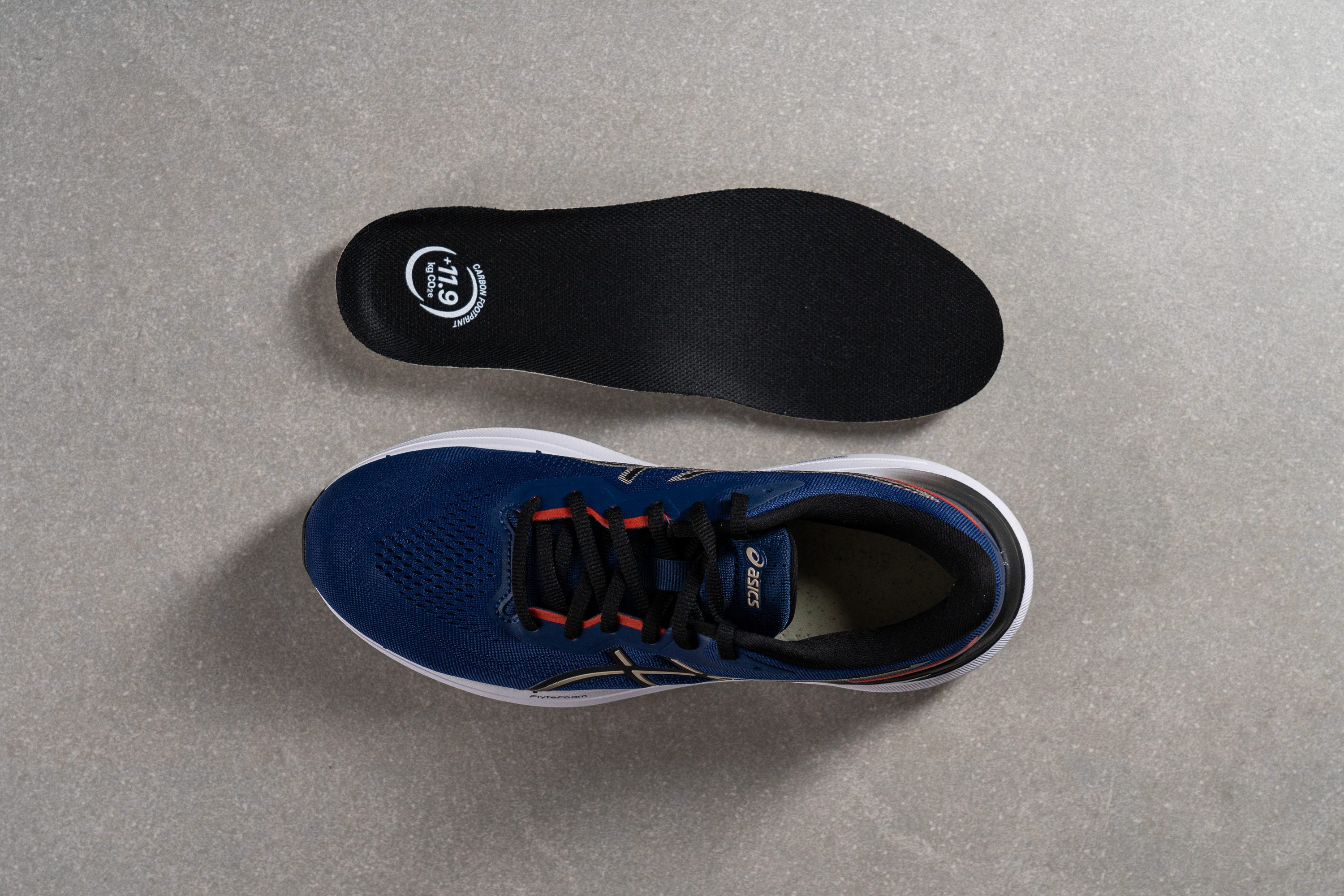
| GT 1000 13 | Yes |
Midsole softness in cold (%)
Runners that love colder climates can be assured that FlyteFoam won't become overly hard. Following a 20-minute test in the freezer, we observed that the foam only became 18.4% firmer!
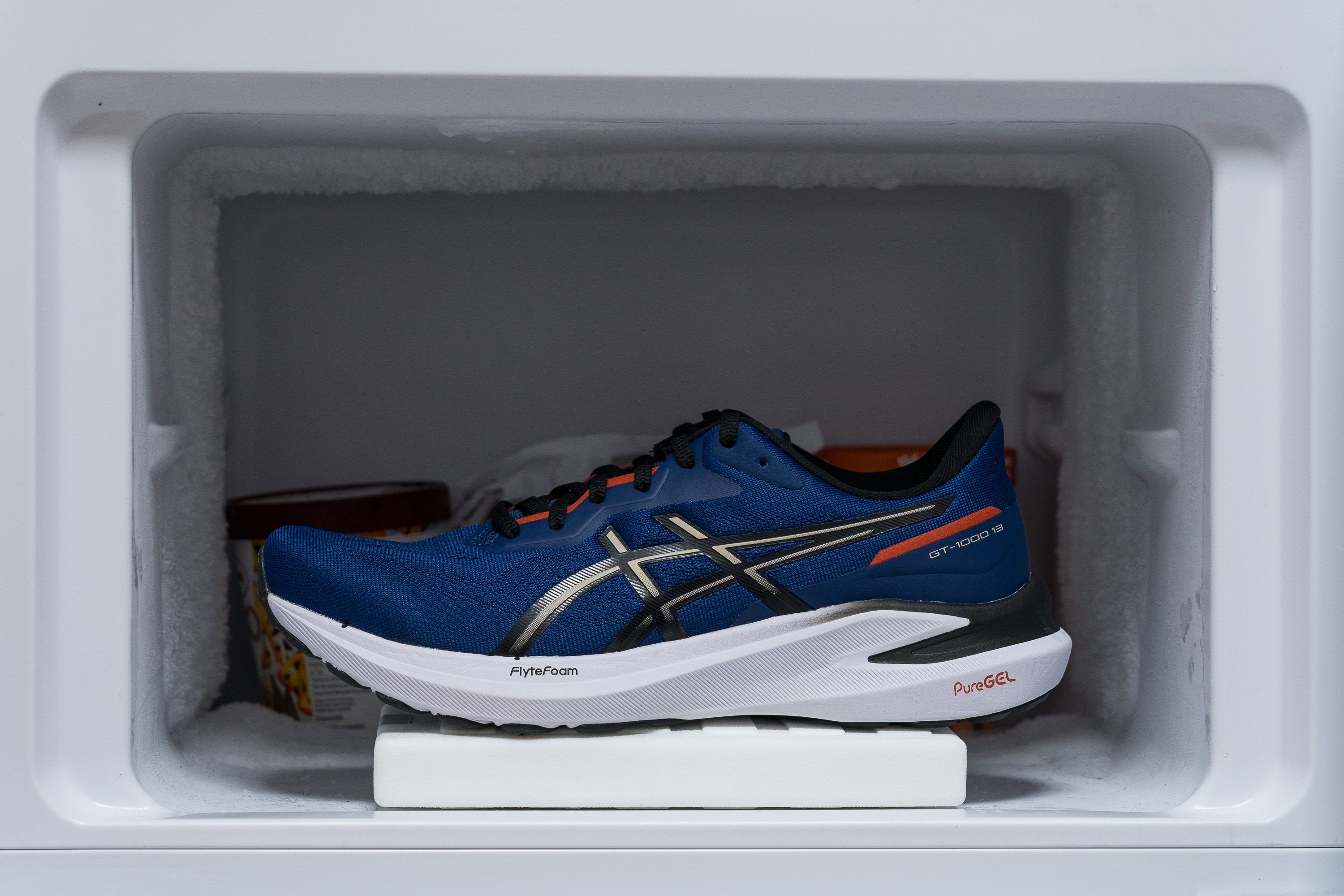
| GT 1000 13 | 18% |
| Average | 24% |
Reflective elements
We discovered no reflective elements on the GT 1000 13, which didn't come as a surprise.
Adding reflective details is a simple and cost-effective method for brands to enhance the perceived value of shoes. Given that this model is priced around the hundred-dollar mark, we think that ASICS decided against including them.

| GT 1000 13 | No |
Tongue padding
Despite its budget-friendly price, ASICS didn't compromise on comfort everywhere, and we found the tongue to be exceptionally cushioned. It boasts two layers of foam, combining for a total thickness of 8.1 mm.
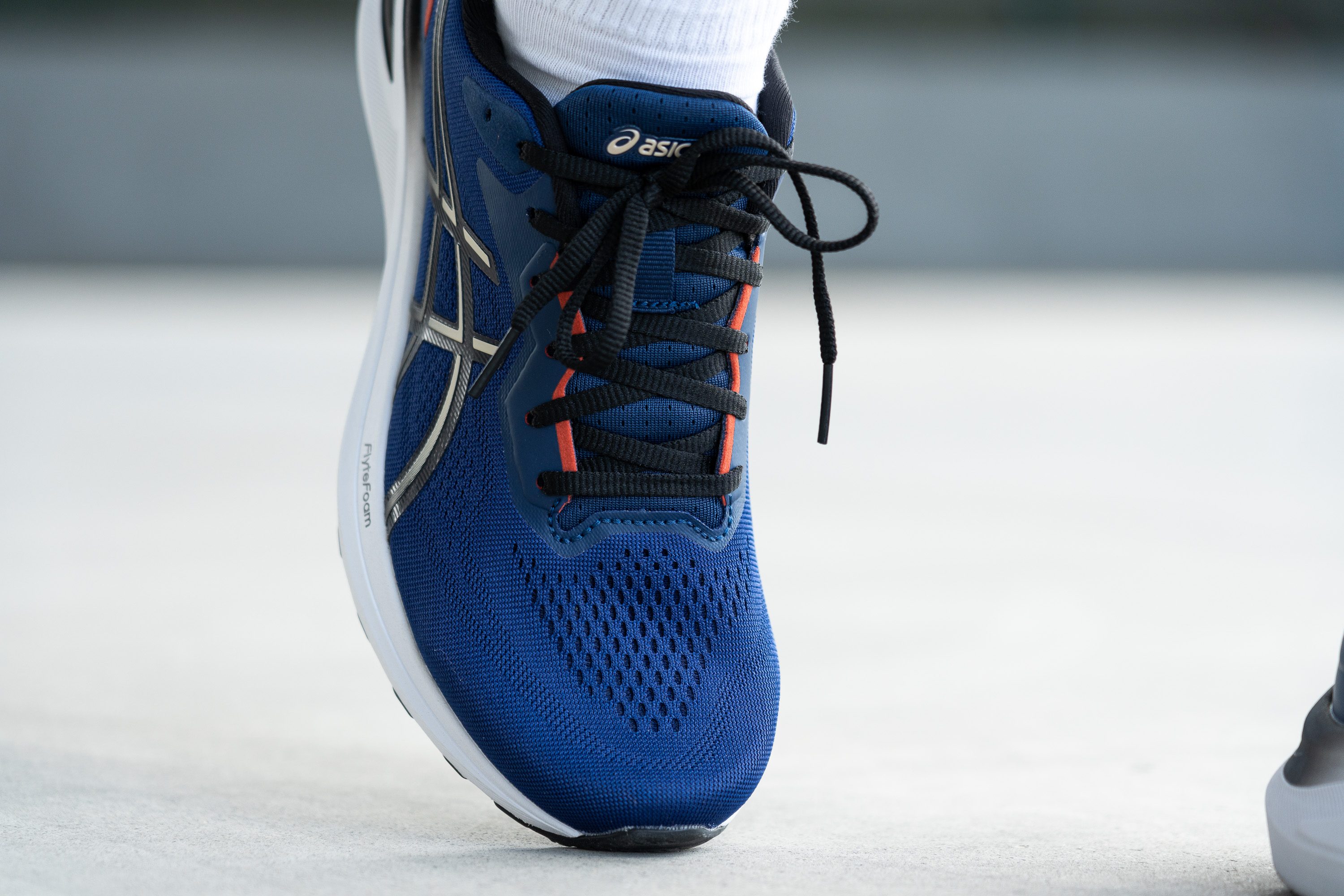
This is excellent news for runners who often experience discomfort in the instep or those looking to benefit from the enhanced plushness of the GT 1000 during long runs.
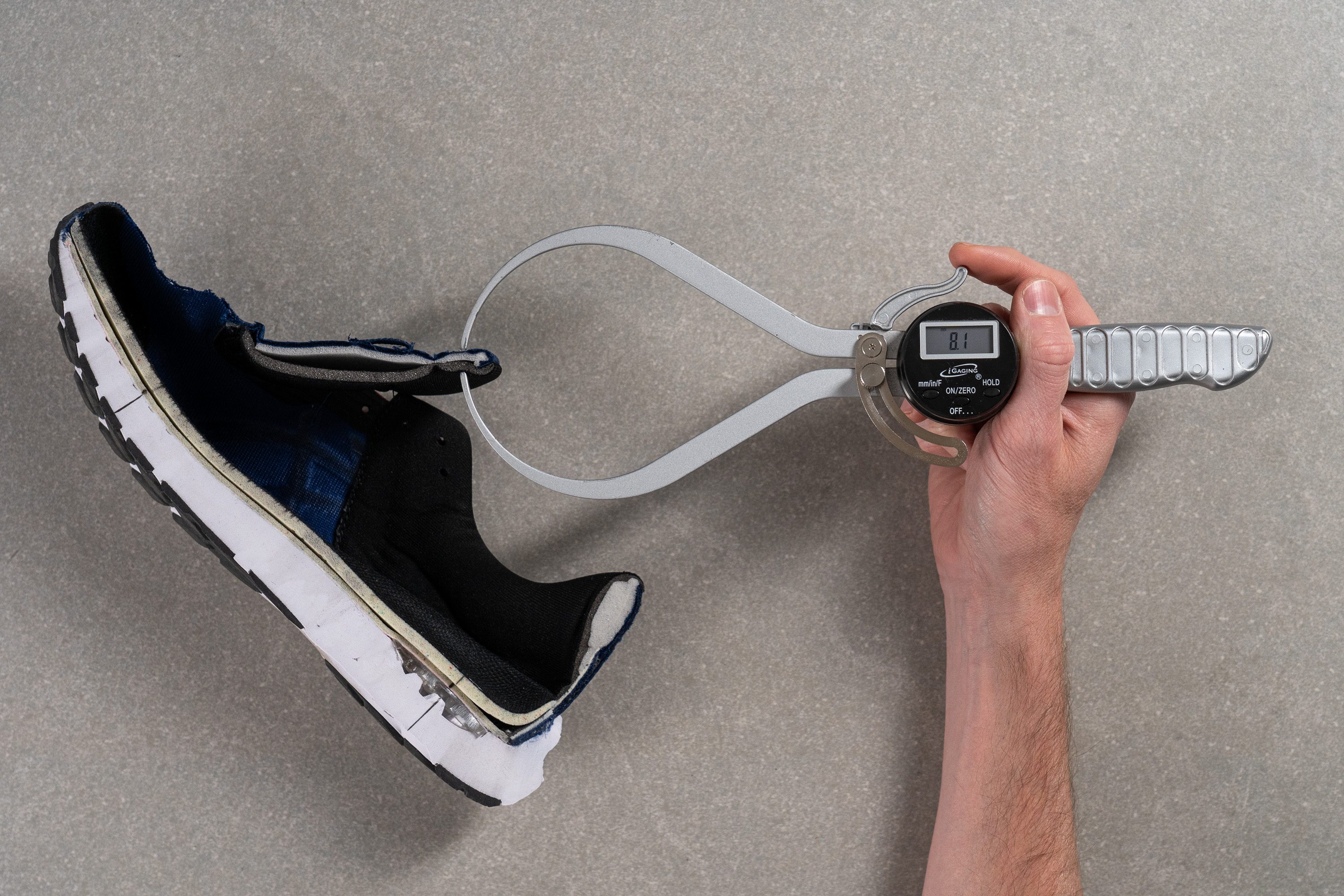
| GT 1000 13 | 8.1 mm |
| Average | 5.8 mm |
Tongue: gusset type
ASICS continues to overlook the addition of a gusseted tongue in its budget-friendly models, which explains why the tongue of the 13th edition of the GT 1000 still shifts around freely.
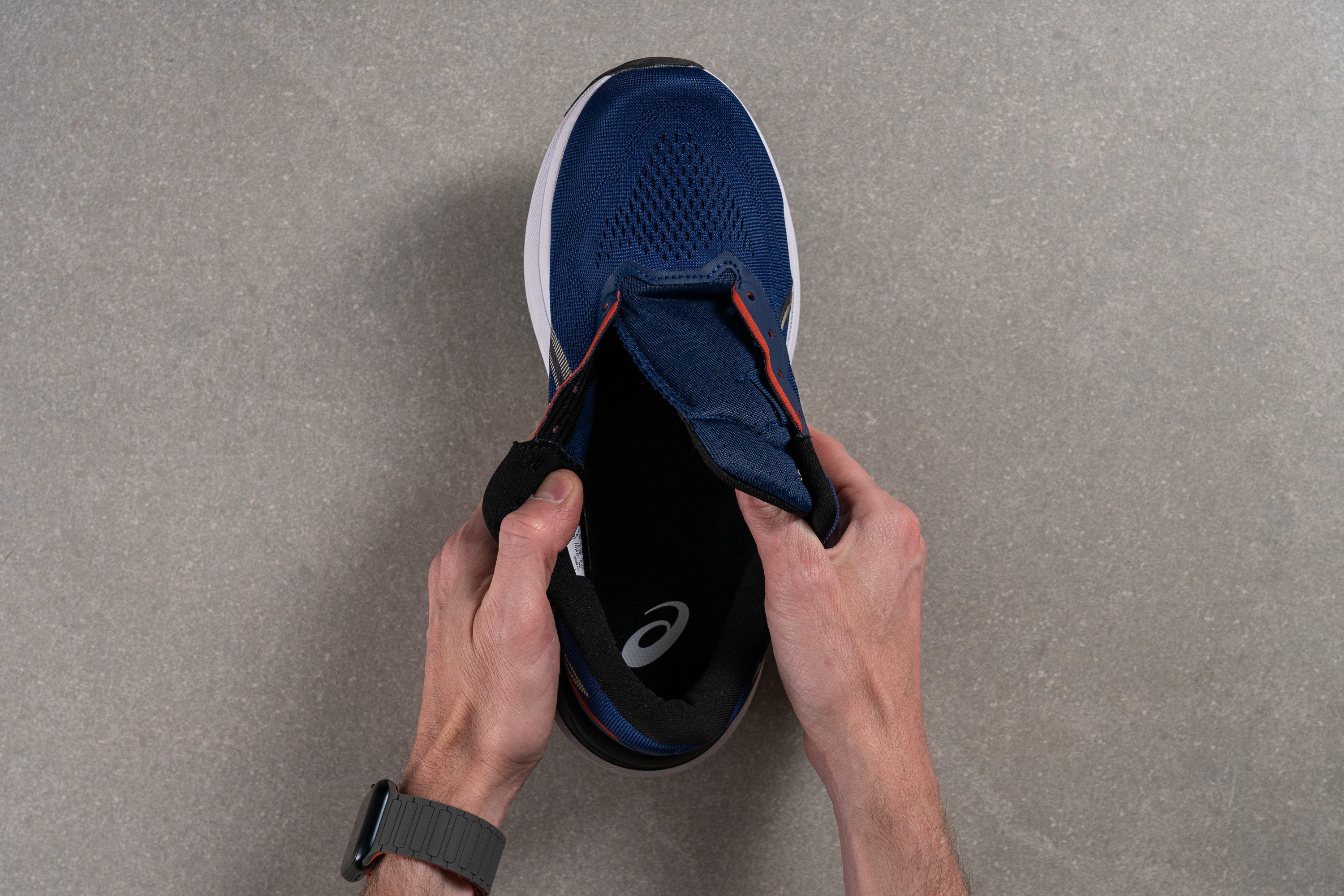
| GT 1000 13 | None |
Heel tab
We weren't happy to find that ASICS did not include a finger-loop heel tab in this version of the GT 1000 13, despite our previous hopes in our lab review of the GT 1000 12. Regrettably, the heel remains boring and devoid of any tabs!
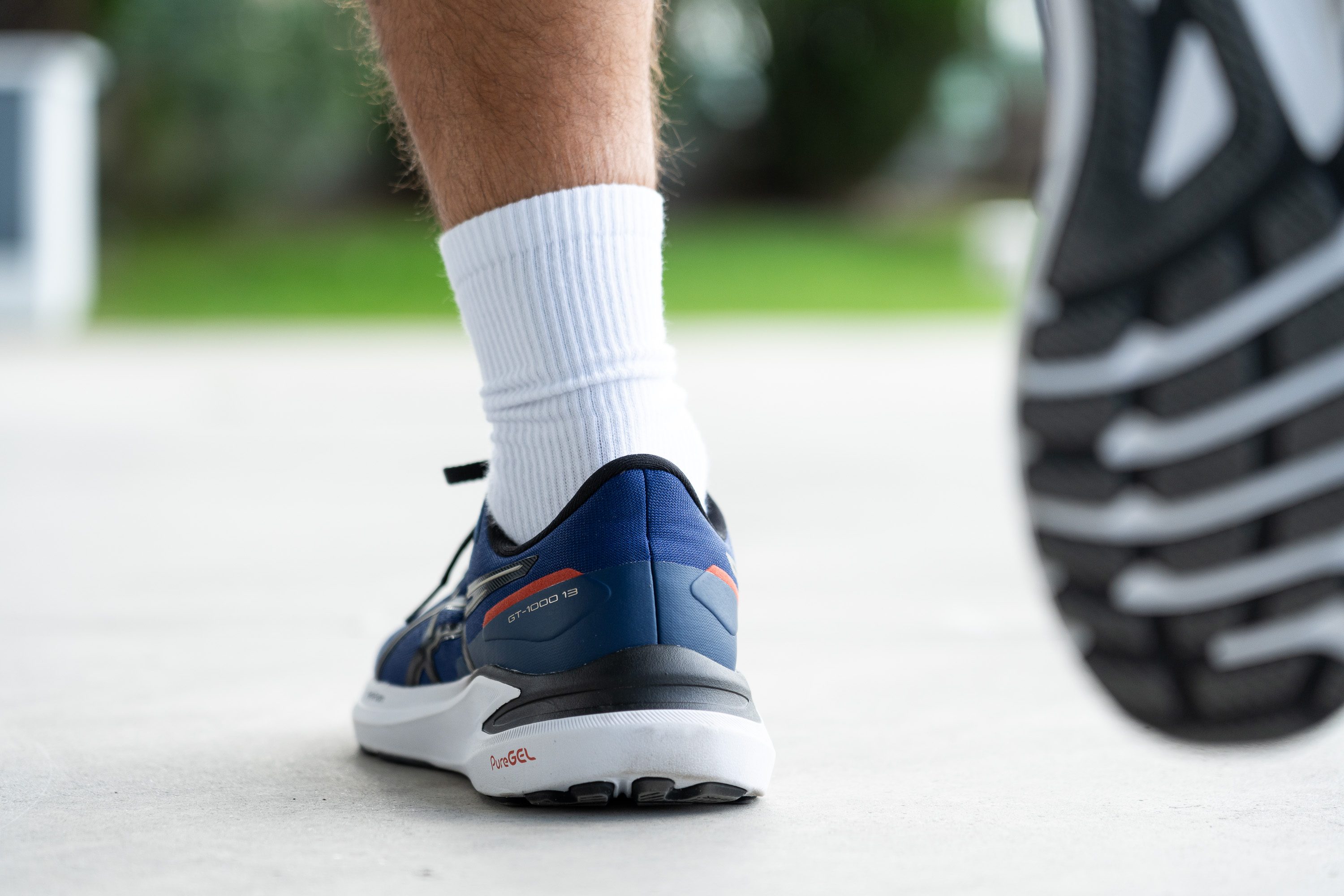
| GT 1000 13 | None |

